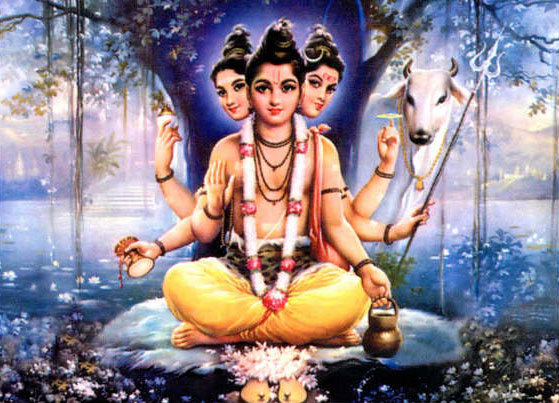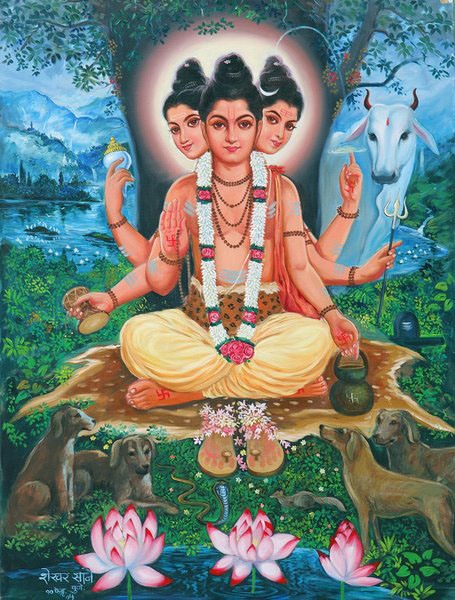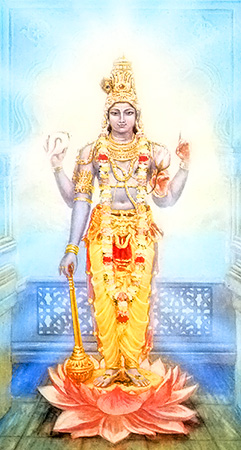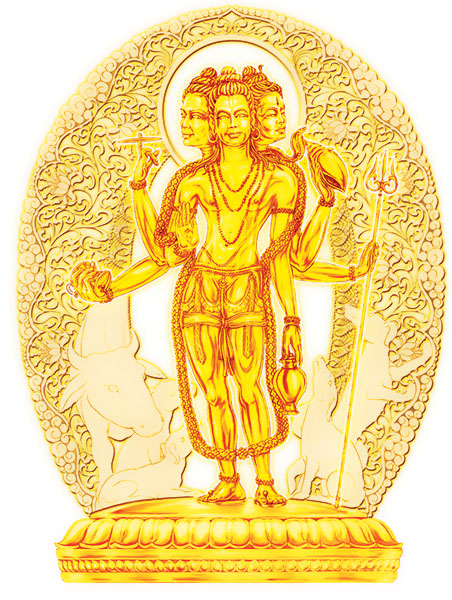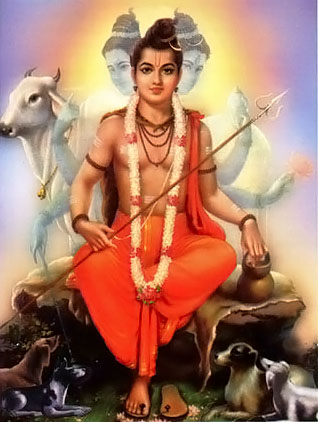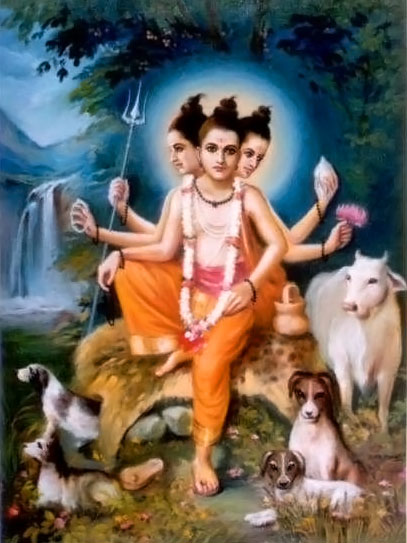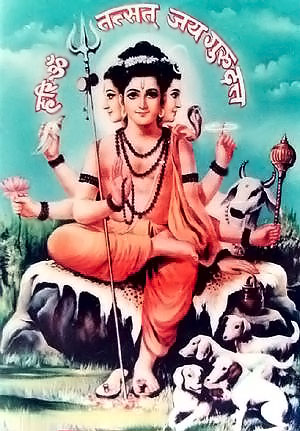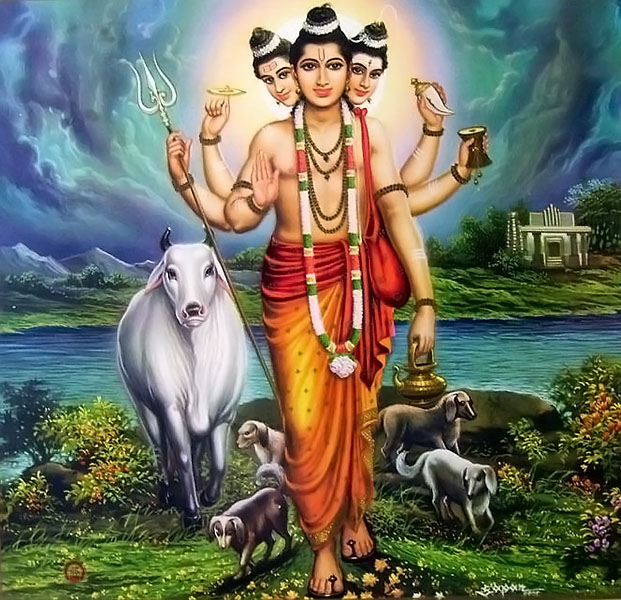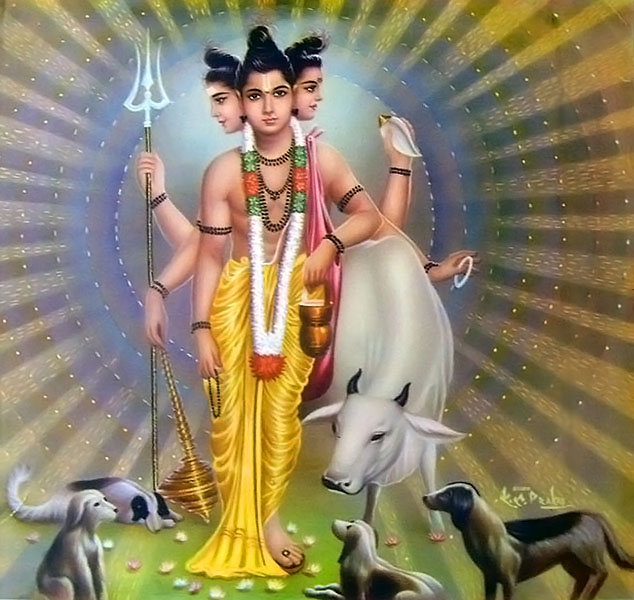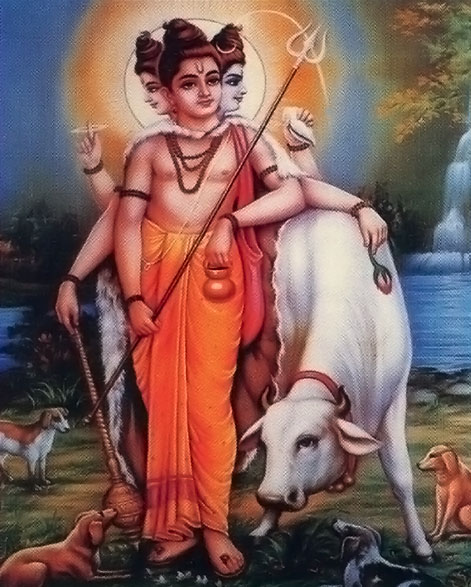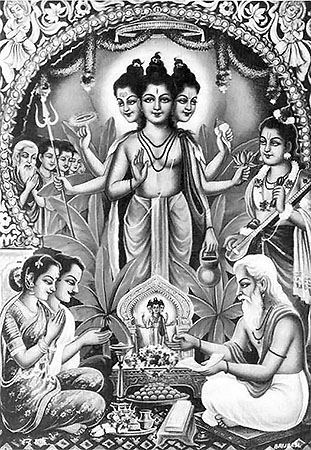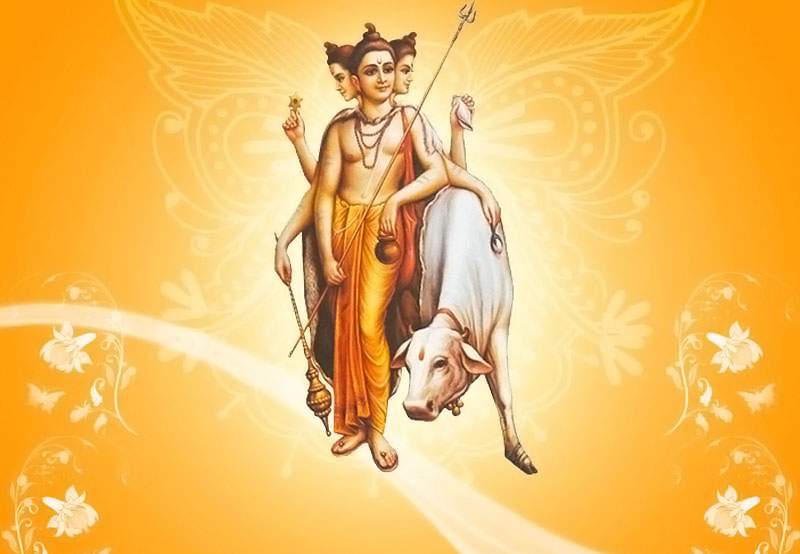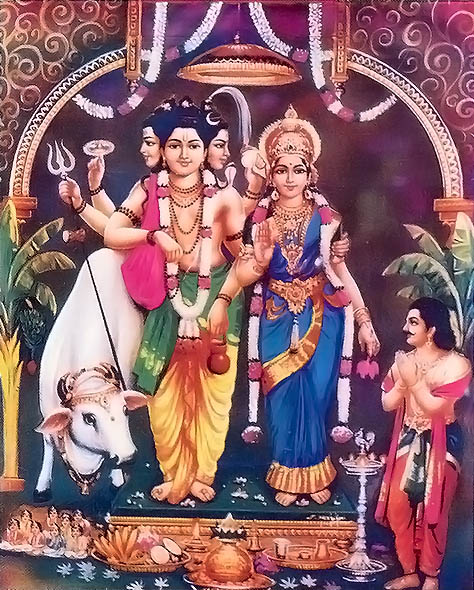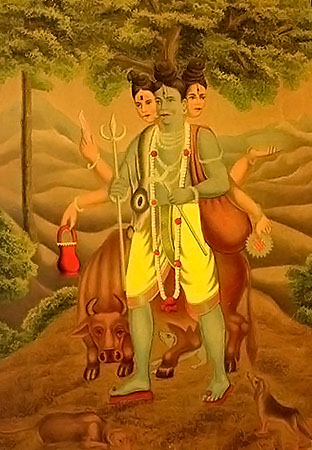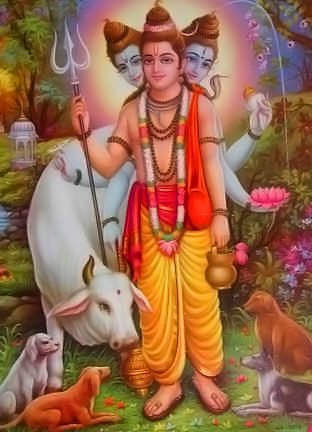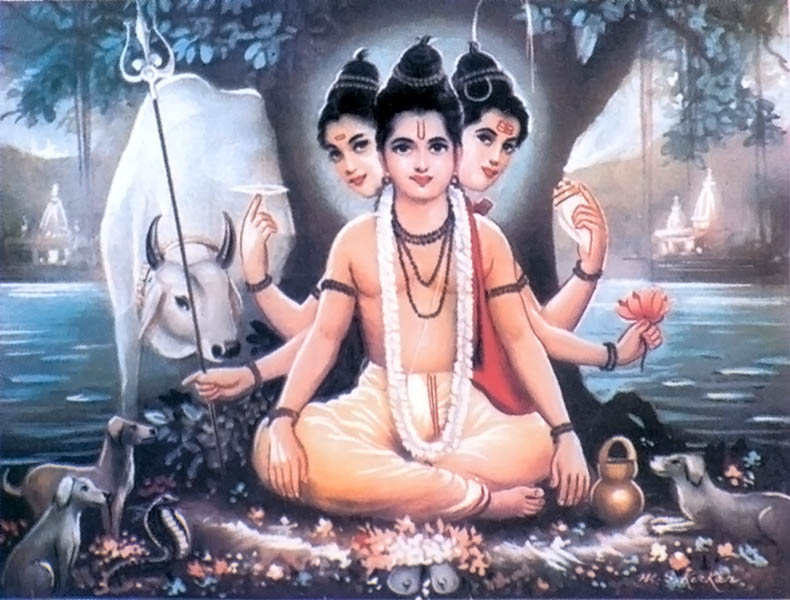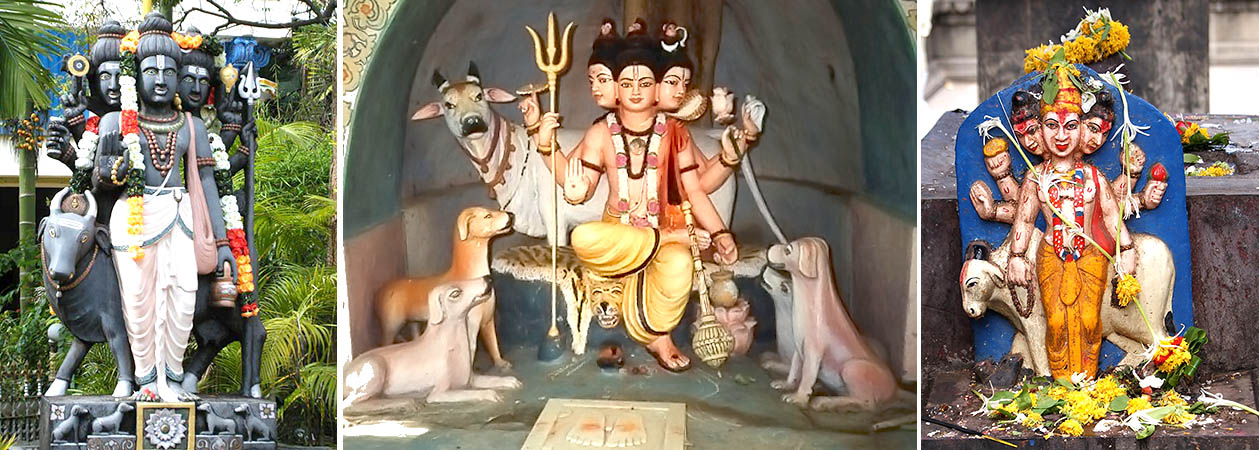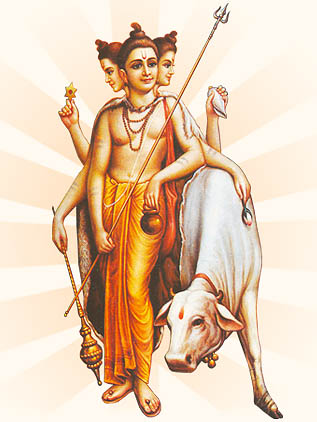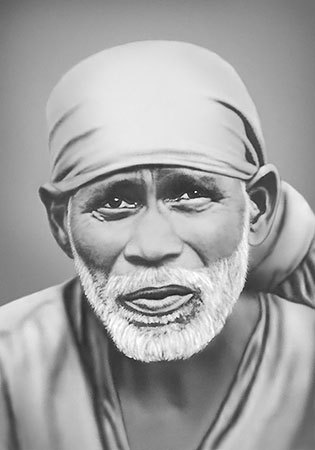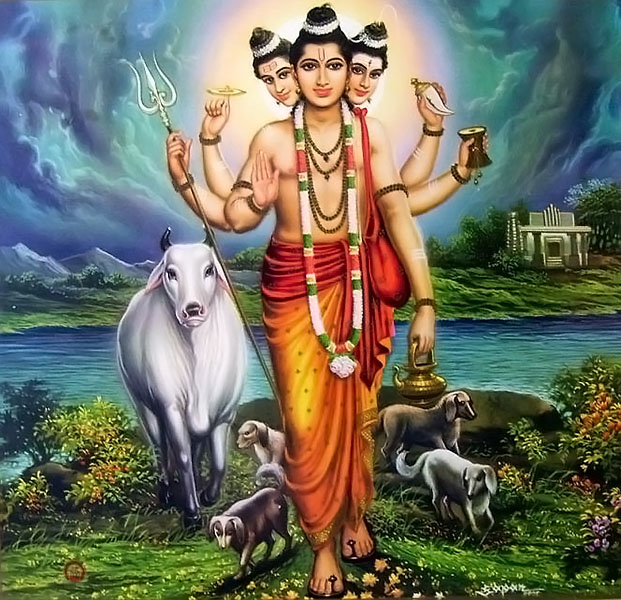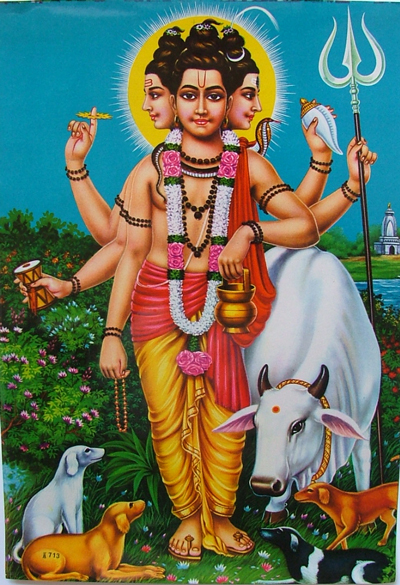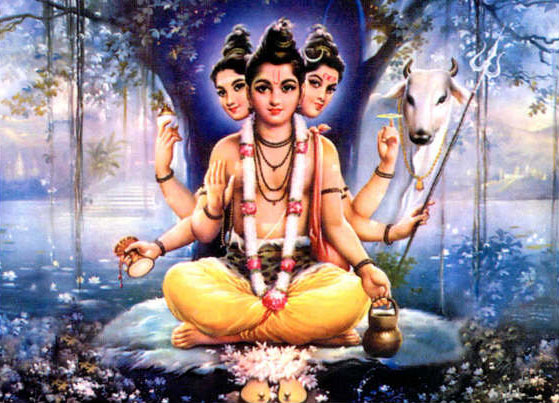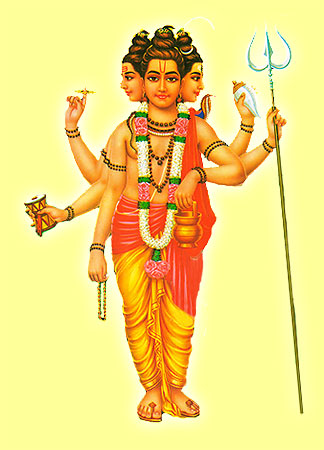|
Calendar Veda Loka
2025 THE YEAR OF DHARMA PREACHING
12 July
Saturday 2025 year 00:00:00
Time
chronology 5121 years of Kali Yuga,
28th Mahayuga 7th Manvantara The era of Manu Vaivasvata boar Kalpa first day of 51 years of the great First-God-Creator |
||
|
Latest Updates
|
||
|
Video Updates
|
||
DATTATREYA AS GURU OF MANKIND
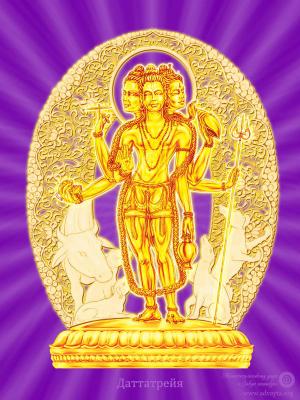
- The preface of the author
- Chapter 1. Dattatreya as ishtadevata Glorification to Dattatreya
- Chapter 2. The description of the attributes and features of the deity Dattatreya
- Chapter 3. Sadhana of Calling for Dattatreya’s blessings and protection
- Chapter 4. Collection of practices of calling for Dattatreya
- Chapter 5. Collection of texts by Dattatreya
The preface of the author
Every spiritual seeker sooner or later comes to the conclusion that the world of people, the path of people, their values and purports do not exist on their own. They are based on something bigger, deeper, something that is more sacred, immaterial, veiled, secret, and divine.
Only when we get into the heart of that secret and sacred sphere of divineness, we can find answers to all the questions. It is useless to seek answers to the fundamental life questions, to seek the truth in our profane dimension.
Our world can’t give us the true answers to these questions, it can only show us the way to move, give an idea of immaterial divine reality that is usually concealed. This divine reality has always been with us, it has never left us, but once in the past we lost a connection to it, forgot about it and excluded it from our life.
By taking a spiritual path, purifying from literalness, klesha and selfishness, a spiritual seeker approaches this divine reality once again, enters this dimension and stops in reverence, delight and amazement being deeply astonished.
His spiritual eyes open, and then he realizes how mystic, sacred, multiple, incomprehensible, mysterious, enigmatic and diverse our reality is.
After a spiritual seeker reaches this level, he becomes enlightened and finally realizes that the world is divine by its nature, and everything that exists on the earth mirrors in the divine dimension (let’s remember the famous quote by Hermes Trismegistus: "As Above, So Below"), but this reflection is much deeper, exquisite, perfect and true.
To be more precise, our physical world is an imperfect gleam of the divine dimension.
When a seeker enters this dimension, he inevitably meets powerful divine forces, siddhas, gods, angels, inscrutable shining creatures, that live in higher dimensions, according to different laws. They think deeper and quicker, they see this world in a completely different way, they know the past and the future of this world, remember every word that one has said since his birth day, understand him better than he understands himself.
There he meets the creatures who do not know what ignorance, death, sufferings, pain, illnesses, sadness, restrictions mean, the creatures who do not live a human life but play, enjoying their wisdom, with those who do not know what time and space mean, those whose auras radiate light in countless directions, who have not one body, but as many as one wishes, those who create worlds, Universes, civilizations, cultures by using a simple will power, those who control the processes of the Earth and other planets, those who perceive this world as oneness of a mind, the mind that does not discriminate between a subject and an object.
These siddhas, rishis, gods, divine beings are our great ancestors, progenitors, precursors and creators of our civilization.
A sincere truth seeker cannot avoid meeting the divine creatures on his spiritual path. If this meeting does not take place, it means that he lacks efforts, belief or good karma.
We cannot avoid the divine creatures on our spiritual path, because in a way, they are our own selves, the sacred and holy part of us that uncovers itself for our inner eye in an appropriate time; this is our inner “self” mirrored in Absolute.
At the same time, the divine creatures are a manifestation of the cosmic forces which are immeasurably greater than we are, more global, more complicated, unbelievably profound and inscrutable.
These forces are unrestricted; they may be formless or take a shape of an individual, they may have no body or have milliards of bodies throughout the Universe, their purity and perfection are beyond comprehension, their wisdom is hard to accept, their thought is inconceivable, their goals can’t be controlled by a human mind, their actions are beyond our understanding and even meditation.
It’s impossible to understand them, you can only believe in them, call them for help, identify yourself with them, join into oneness with them, and eventually discover these forces inside yourself.
Among these great forces is a divine Master of all yogis, Guru of all Gurus, avadhuta, divine sage, Bhagavan Dattatreya.
Dattatreya is a great cosmic player who is being beyond the bounds of time and space. Dattatreya is Brahma and Vishnu and Shiva and Krishna; he is both Rod and Veles, Perun and Svarog, Hermes Trismegistus and Tor, Odin and Zeus and Poseidon; he is both Vasishtha and Shankara, Buddha and Christ, Padmasumbhava and Lao-tzu.
There is no one or nothing that Dattatreya could not be. This is how great his nature is, how deep his personality is and how infinite his energy is.
The path of Dattatreya is the path of an absolute natural freedom, the path of an intuitive play with reality, spontaneous wisdom, based on comprehension of the divine essence of the Universe.
As divine avadhuta, Dattatreya dances in space, floats with clouds, flies with wind, flows with rivers and waters and stays motionless with mountains.
Dattatreya, full of compassion and wisdom, always waits for those who are looking for a way to a true freedom. One way or another, each of us takes Dattatreya’s path; no matter how we name it, what we believe in and what life principles we follow, because the true Way to freedom is always one, even if it seems that there are a lot of them.
It is a way to divinity and unity.
Svamy Vishnudevananda Giri
Divya Loka, August- November 2010.
Chapter 1Dattatreya as ishtadevata
Glorification to Dattatreya
Again and again,
trembling with joy,
crying in delight and devotion
together with all living beings,
with all my body, speech and mind,
I glorify that greatest Lord,
Guru of all Gurus,
Lion among the men of wisdom,
The king among all yogis,
avadhutas and siddhas,
God among gods –
Bhagavan Dattatreya,
Him who is an absolute Truth himself,
who is the supreme Bhagavan,
Who possesses six infinite
perfections:
Almightiness (ayshvarya)
divine power (bala)
divine glory (yashas),
Universal variety of energies and prosperity (shri),
divine knowledge (jnana)
and also renouncement
and self-sufficiency (vayragya).
Again and again
I glorify that greatest Lord,
Who is being Parabrahman himself,
gives birth to worlds and universes,
who contains Brahma, Vishnu and Shiva as well as their spouses and suites,
The one who omniscient, pervasive
Shaktiman – the Lord of all powers in the universe,
The one who possesses three great divine powers of the universe:
Wisdom,
will and action,
manifesting as Mahasarasvaty,
Mahalakshmy and Maheshvary.
I glorify the greatest one,
who is eulogized by rishis, kumaris, siddhas
for his infinite wisdom,
power and glory,
That overlord of all yogis and siddhas,
who contains in himself all devatas,
Such as Indra, Vayu, Soma,
Surya, Varuna, Agni,
Kuvera, rudri and marutas,
Who is a receptacle for millions
of gandharvas, charanas,
vidyadharas, apsaras, kinnaras,
yakshas , guhyakas, nagas
and other magical creatures,
The one who is in the heart
of every Guru, every sage and sadhu
As his supreme “Self”
In form of space of pure consciousness,
is just like an endless sky.
The one who is unsurpassed, who possesses the five great powers
And can create, maintain, dissolve,
bound with his maya (illusion)
He who possesses mercy (Anugraha) can pardon
countless creatures of this sansara.
Glory to you a thousand times over,
glory to you, oh Bhagavan Dattatreya!
To you, whose name
mentioned with trust
or even without it,
intentionally
or by accident,
Releases from innumerable sufferings
and sins
and provides us with unbelievable knowledge,
forces and blessings!
The prayer to Dattatreya
“Oh holy Guru! The Lord of all yogis! Oh, Dattatreya, the son of Atri and Anasuya!
The one who embodies all gods, his glance gives liberation! Oh Avadhuta, to you I’m invoking my devoted heart!
Send me the flow of your mercy, light me up with rays of your bliss. Send down your compassion to me, stuck amidst illusions, give me your power, eliminate my doubts, disperse my ignorance, karma and kilesa.
Defend me, oh Lord, like a warrior and shield, from sansara, awake my belief and wisdom.
Oh, Avadhuta, grant me your power, fearlessness, gladness and wisdom. I pray, show me the right way”.
This is a prayer to Bhagavan Avadhuta Dattatreya for defense and elimination of doubts (it should be read in difficult situations, when you have doubts and obstacles).
The story of Dattatreya
Bhagavan Dattatreya is a Master of all Masters, primordial Mentor for all yogis and siddhas. He embodies the principle of Advayta and self-released behavior – a play in the face of avadhuta.
Dattatreya personifies the Trinity of gods (Trimurti): the Creator, Keeper and Destructor (Brahma, Vishnu and Shiva) who embodied in the family of Atri and Anasuya and gave them a bliss, after which Anasuya gave them a lesson of being submissive and pure.
Not only does he personify the divine Trinity but he also symbolizes the Way and the goal of the absolute Truth and Reality. He is the Truth himself.
The word “Dattatreya” consists of 2 words – “data” and “Atri”. In Sanskrit “data” means “given” or “suggested”.
The Lord in the Highest gave himself to the wise man Saint Atri and his great wife Anasuya, that is why he was named Dattatreya.
“Sandilya -Upanishad” gives a story about Dattatreya who embodied in Atri’s son, “Utterly satisfied with the great asceticism (tapas) performed by the man of wisdom Saint Atri who wished to have children, the beaming Dattatreya gave himself to Atri. And as he was born in the family of Atri and Anasuya, he was named Dattatreya”.
Once upon a time there lived an old Brahman Bharata-varshi. He was suffering from leprosy which was a kind of punishment for the sins he had made in life. His wife was a hermit who had a rare willpower and was endowed with submission and chastity.
She was very faithful, caring , she loved her husband no matter what and took care of him with a great devotion and selflessness.
Once in a night time she was carrying the body of her sick husband in the road that went close to a tree. Under the tree a saint hermit and ascetic was meditating who was endowed with great powers.
As it was dark, the woman didn’t notice the ascetic, and when she was passing by, and the feet of her husband accidently touched the body of the meditating hermit.
The hermit got angry and damned her husband saying, “The one who touched, hit pushed me, who interrupted my meditation will die tomorrow at the sunrise”.
The brahman’s wife was very scared and frustrated with what has happened. But after she pulled herself together, she calmed down her mind and thought that if the hermit can damn her husband with the power of tapas, she can defend her husband with the power of her tapas. That is why she took the following oath:
“If destined so, then since tomorrow the Sun will never raise anymore! Rather the Sun will never appear in the sky, rather there will never be the light in the world than my husband dies!”
Spirits hid of fear, mountains began to tremble, and heavens reeled from such a great oath of the sacred woman who was endowed with the power of ascesis.
As what was pronounced as an oath by the hallowed woman, by all means should have come true, the next day the Sun could not raise. The world plunged into darkness, the dark was everywhere, and the chaos set it everywhere. Even the gods – the world’s keepers came to great anxiety.
After they had organized an urgent meeting and started meditating, they quickly found out the reason by using their power of clairvoyance. But what could they do? Nobody can cancel an oath of the devotee.
When they discovered what has happened, they immediately went to a sacred abode of the Brahma (Brahma Loka) to the Creator to find a way out of the challenge. Brahma said, «Only a great force can overcome the other great force, only tapas can surpass another tapas.
The power of the sacred woman has stopped sunrise, which means you should ask another great sacred woman for help, the woman who can compete her power and bring the sunrise back».
After Brahma finished, Gods started searching for such a woman. They looked fixedly at people and examined their karma.
After a while they found a righteous woman, the great hermit Anasuya, a pure and meek spouse of a wise man-rishi Atri living in the woods.
They told her the story about the Sun, about what Brahma told them and eulogized her sanctity and submissively asked her for the help.
Anasuya agreed to save the world from the darkness and chaos.
She came to brahman’s wife and said humbly with her bewitching and melodious voice,
“The power of your words has stopped the Sun rise, so look now – the entire Universe is in chaos. I have come to find out if we can come to agreement and start the Sunrise again.
If you cancel your oath and ask the Sun to rise again, and if your husband dies, I will raise him from the dead with the power of my selfless devotion”.
The wife of the brahman agreed. The Sun rose, and her husband, the brahman who was damned by a hermit, died, but Anasuya kept her promise. She raised him from the dead.
Gods were very happy about that, and to show their gratitude, they suggested Anasuya choose any kind of blessing she wanted.
In response to that she said that she wanted Brahma, Vishnu and Shiva to be born as her sons, and gods promised to grant her desire.
As a result of that promise, Brahma was born as Soma (the Moon), Vishnu as Shri Dattatreya, and Shiva as Durvasa Muni, the siddha who is being angry very often.
Many Sacred Writings tell about greatness and holiness of Shri Dattatreya.
Sometimes he is described as an avadhuta, a wandering ascetic, hermit and a yogi, granting generous blessings, and sometimes as a householder immersed in a pleasure, enjoying entertainments and luxury.
These qualities were a kind of play (lila) to mislead the foolish people, yoga-maya that he used to demonstrate in front of ordinary people as a blind for their curious eyes, hoping that they will take him as a usual person and will leave him alone.
However, the true wise men saw his true nature and always remained close to him, receiving his blessings and teachings.
When the Truth Path is lost in the world of people, and Dharma goes bad, the incarnations of Dattatreya appear on the Earth, and after Truth Path if found again, when the purpose of the incarnations is achieved, they leave the Earth.
Bhagavan Dattatreya himself never stops existing – even when the general lysing (pralaya) starts. He is immortal, eternal; after all he is Bhagavan, Sahadja itself, the infinite, immemorial Truth.
Sacred Writings about Dattatreya
In “Dattatreya-Upanishad” Dattatreya is described as the one who Brahma and Vishnu meditate on, the one who is Parabrahman himself.
«Once Brahma Creator, being in Satya Loka which is his own universal heavenly kingdom asked the Lord Narayana about the effectiveness of taraka-mantra, and he said the following:
«Always remember about me and my glory; also be in a close unity with me, believing: «I am Datta, the supreme Lord». Those who meditate this way do not appear to be seized by sansara».
After an appropriate meditation on the Lord Vishnu in aspect of Narayana and Dattatreya, Brahma said, «Yes, what remains after you disclaim everything else is the only one Brahman, who is eternal and matchless».
“Dattatreya-Upanishad”
Several stories about Dattatreya are mentioned in “Mahabharata”, “Bhagavata Purana”, “Vishnu Purana” and also in “Markandeya Purana”, where we can find his brief biography.
A detailed description of the essence of Dattatreya can be found in “Shandilya-Upanishad”:
“Then Shandilya asked Atharvan the following question, “How does this Universe emerge from Brahman, who is “Ohm", eternal, inactive, salutary, pure Aseity and the Supreme Being? How can the Universe exist in him? How can it dissolve in him? Please, resolve this challenge”.
Atharvan answered: “The Out-of-Sight Brahman, the True, is eternal and inactive. The three forms (aspects) originate from the shapeless Brahman – nishkala (free of parts), sakala (with parts) and sakala-nishkala (with parts and without them).
What is satya (true), vidjnyana (divine knowledge) and ananda (pleasure), what is inactive, free of any impurity, omnipresent, exceedingly exquisite, directed simultaneously to all directions, indefinable and immortal is his nishkala-aspect.
Maheshvara (the supreme Lord), who is black and yellow, rules avidya, mula-pracriti or maya, which is red, white and black, and which coexists with Him. This is his sakala-nishkala-aspect.
Then the Lord by means of his spiritual Mind declared: «May I become many! May I extend everywhere! Later this out-of-sight personality, that was being in ascesis, that had the nature of knowledge and desires that always came true, generated three letters (A, U, M), the three vjahriti (Bhuh, Bhuvah and Svaha), the three line Gayatri , the three Vedas, the three gods (Brahma, Vishnu and Shiva), the three varnas (the Brahmins, Kshatriyas and Vaishya ) and the three fires (garhapatya, ashavaniya and dakshina).
This supreme Lord has everything in abundance. He runs through everything and stays in the heart of every human being. He is the Great Mayavi, playing with Maya.
He is Brahma, He is Vishnu, He is Rudra, He is Indra, He is all gods and all beings.
He is east, He is west, He is north, He is south, He is below us, He is above us, He is everything.
His form of Dattatreya playing with his Shakti, is merciful to his devotees, shining like a fire, like petals of a red lotus, it has four hands, it is lenient and it shines sinlessly – this is his sakala-form”.
Then Shandilya asked Atharvan,“Bhagavan! That something that is only a Being and the essence of bliss of the Consciousness, why is it called Parabrahman?”
Atharvan answered: “Because he increase the greatest and makes everything increase, that is why he is called Parabrahman”
Why he is called Atman?
Because he achieves everything, because he takes away everything, because he is everything, - that is why he is called Atman.
Who is the one called Maheshvara (the supreme Lord)?
Because of how words Mahat-Isha (the supreme Lord) sound and because of his own power, the supreme Lord rules everything.
Why is he called Dattatreya?
Because the Lord, being satisfied with how rishi Atri fulfilled the most difficult ascesis and expressed his wish to have him, who was the Light himself, as his own son, decided to give himself to the sage Atri and his wife Anasuya, who became Dattatreya’s parents.
That is why the one who knows the secret, knows everything. The one who always meditates on the incomprehensible which is That, becomes the one who has cognized Brahman. The following shlokas pop up in mind:
The one who always meditates on the God of all gods and on the Eternal in the face of Dattatreya who is soft-placid, appeased, shining with the dark-blue light of a sapphire, who is the great Lord, enjoying the bliss in his own creation (maya), divine, the philosopher-avadhuta, with the four parts of the world as his habiliments,
With the body covered with the sacred ashes, with entangled hair of the supreme Lord, who has four hands, remarkable extremities and the eyes that look like the petals of a fully bloomed lotus.
Possessing the wealth of Spiritual knowledge and yoga, the world-wide master, dearest to yogis, compassionate to devotees, the witness of the one for whom sacred wise men carry out the service,
The one who always meditates in this manner on the God of all gods and the Immemorial, can be released from all sins and attain Liberation».
“Shandilya - Upanishad”, chapter III
Dattatreya as Bhagavan
«I bow before the Lord Dattatreya, the embodiment of Sat-Chit-Ananda, the greatest among yogis, the highest Soul».
"Dattatreya-kavacha"
Dattatreya is the Absolute himself; he is incomprehensible Parabrahman without attributes and qualities, the one who is beyond time, gunas, name, and form. He is the supreme Mind, the Life Source, Alpha and Omega of everything, therefore he is called Bhagavan.
It means that his energy, mind, name, speech, body and form are inseparable from Parabrahman, being its mandala, the purest creative manifestation.
When he is going to show his play, manifestation, power and force, he is described as Bhagavan.
Bhagavan is always only one, it is Parabrahman himself, described as the Being - Consciousness – Beatitude (Sat-Chit-Ananda).
There is no other in him, as nothing exists but him. If they talk about any living being calling it Bhagavan, it means that this living being is Parabrahman in all his playinging completeness, magnificence, power and glory.
Bhagavan is that one who is endowed with «bhaga». What is bhaga? The word « bhaga » includes six absolute advantages, perfections.
Absolute divinity (Aishvarya)
It is a perfect divinity (ayshvarya) which is manifested as omniscience, greatness, bliss, pervasiveness, purity, beauty, love, harmony, eternity, infinity, incomprehensibility, power, force, supernatural forces etc.
Dattatreya is absolutely divine, though he often hides it behind various masks of a usual man, sadhu, beggar or the one who likes pleasures and entertainments. This is why his plays are so inscrutable.
A usual person, whose spiritual eyes are not open, is incapable to recognize the depth of Dattatreya’s play which is beyond duality.
Dattatreya is not a body, but Ishvara – the source of all bodies. His uncountable divine bodies are sitting solemnly on the shining thrones in the heavenly palaces and the uncountable Universes of Mahar Loka, Svarga Loka. These divine bodies can create their own parts – expansions (amshavatars) and send them to the world of people and other dimensions.
One body of Dattatreya can stay in Samadhi in mountains, being in motionless meditation, and by the power of his Samadhi, his mind can create a lot of physical bodies, each of them having a separate will, intelligence, memory, karma, mission, environment and endowed with its own sankalpa.
Perfect divine power (viryam, bala)
Dattatreya’s perfect divine power (viryam, bala) is his ability to show a quinary force (pancha-kriya), to make five kinds of actions – to create, to support, to destroy, to bless, to punish by bringing into illusion.
Perfect divine glory (kirty, yashas)
The divine glory of Dattatreya is his expanded aura; it is his vibhuti, the manifestation of his mercy as Ishvara – the Lord of the Universe. The Dattatreya’s glory is unlimited; it is manifested as his wisdom, blessings, inspiration, an effluence of light etc.
Perfect wealth and prosperity (shri)
This perfection includes all the happiness, luck, immortality, well-being, boundless prosperity of this and other worlds.
In our world it is manifested as a financial prosperity, success, courage, good health, long life, free time, various abilities, home, wedlock, children, security, happiness, comfort, and well-being.
Dattatreya possesses perfect wealth in any aspect. He can show up in any dimension through his illusory bodies. He can take the shape of a devata, man, statue, sacred text, temple, sadhu, householder, siddha, king, wood, river, mountain, pure country and even the shape of the entire Universe.
Perfect wisdom (jnana)
The knowledge and wisdom of Dattatreya is, first of all, the knowledge of Sahaja, your own natural Wisdom, non-duality, the knowledge of your own completeness of the Absolute (brahma-aham-bhava), integrity beyond the limits of a subject and object. It is not the kind of knowledge that you can gain by asking questions and speculating. It is how you comprehend your own nature of the Absolute beyond the limits of a name, form, beyond the limits of your thoughts and concepts (amanaska).
All Vedas, Upanishads, puranas and itihasas, sutras, tantras and upadesa originate from the perfect wisdom, but the wisdom itself stays out of any support (niralambha), it is based only on itself, getting knowledge from itself, without requiring any external sources of knowledge.
Dattatreya has a completeness and perfection of this knowledge. The song "Avadhuta Gita" narrated by him to his disciple confirms it.
Perfection of renunciation (vairagya)
Bhagavan Dattatreya is always free from the physical world, from this Universe, free from desires and his own self, from the karma and its consequences, from any actions and their results.
He can play and manifest himself in any way, with everything, without complying with the laws of karma, ethics, morals, but nothing among the physical objects is capable of causing him difficulties because there are no physical objects in his vision.
All objects are he himself as Brahman as well as his energies. All objects appear show up to him as being oneness with his mind, as a source of pleasure (ananda). Sometimes they play a role of a "messenger" (duti), sometimes it can be a role of a "mother", a "sister", but they are never capable of misleading him, they are unable to destroy his samyoga (balance), therefore Dattatreya is called «completely renounced» (purna-vajragja).
Dattatreya is Bhagavan because the one who fully possesses these six qualities is Bhagavan.
Five forces of Dattatreya
In the aspect of the Lord of the Universe (Ishvara), Dattatreya is an active cause of all the things (nimitta-karana).
Being the great Mind, the universal Intellect (Mahapurusha), Bhagavan, the Absolute, the cause of everything, he possesses special qualities and features – the ability to perform five divine actions (pancha-kriya).
1.Creation (srishti)
While creating the Universe, Dattatreya manifests himself in a form of Brahma – the Founder and Creator. The Creator begets the Golden cosmic germ (Hiranyagarbha) that develops into a new Universe.
As the Lord of the Universe (Jagadishvara), he creates, builds up a new world, making it show up through the dark waters of the primordial world of Emptiness and creative chaos (Causal Ocean) using his will power.
Then through the deities of the five elements, kumars, rishis and prajapatis he manifests different creative powers, establishes a cyclic course of time, the structure of the worlds, geometry, topos and regularity of space.
Comment:
In our world he also manifests himself as a cause (karana), generating every consequence, as patron deities of creative energies, the spirits and people of art, founders, creators, builders and inventors.
2. Maintenance (sthiti)
Dattatreya performs a role of Vishnu – the main Keeper of the Universe, the defender and the keeper of balance.
Through devatas, the keepers of the five elements, time and space, he supports cycles and rhythms of the universe (rita) in order for the universal progress (niyaty) could be carried out harmoniously. He protects all live beings as the defender (kavacha) and the keeper of everything.
Comment:
He manifests himself as the earth, a basis of everything, and the one who is inside the earth (urvi), as water and its essence, as the places favorable for life, as the clothes, help, defenders, assistants, healers, roads, dwelling.
Being the keeper, Dattatreya is the Supreme witness (antaryamin), the one who lives in all creatures and induces them to act.
He also manifests himself as the rhythms, cycles, moral and ethical standards, laws, borders, rules and principles.
3. Dissolution (samhara)
In the face of Shiva, Dattatreya brings back the apparent world to the Emptiness, its initial condition. Comment:
ру, he acts as a destroyer of hindrances, obstacles and all the ignorance, as the one who brings the results of wrong actions, punishing ignorant souls. He also shows up as the one who brings diseases (roga) and the one who puts an end to them.
4. Restraining (bandha)
Using the illusory energy (maya), Dattatreya conceals the Truth and divinity with the power of his concealment (tirodhana-shakti). Here, he acts as a supervisor of cause-effect relations (bandha-card) and a giver of karmic results (karma-phala-datta).
Comment:
In this state, he maintains the ignorance of the world of duality. As the keeper of sansara through the deities-lords of karma and the subordinated spirits, he makes sure the souls inhabiting the Universe receive the physical bodies according to their prarabha-karma and experience the results of their actions (karma-phala).
5.Liberation (moksha)
Bhagavan Dattatreya shows his divine power of blessing and enlightening mercy (Anugraha), emancipating ignorant souls from their excessive feeling of attachment (bandha) to their body (deha-bhranti) and illusive idea «I am a creator» (kartritva-buddhi). Here, he is a guide, a giver of freedom; the one who releases a soul from any restrictions, eliminates karmic bounds and any sufferings.
Comment:
As a giver and a guide to Liberation, Dattatreya is manifested through sacred writings, teachers, temples, monasteries, sculptures and images of gods, sacred objects, bhadjans, mantras, doctrines, methods of sadhana.
His manifestations in Anugraha aspect dissolve the illusions of living beings, arouse pure qualities (sattva) in them, let them start self-research (vichara), observation (Drashta-yoga) and to become a witness (sakshi) of all actions.
He teaches to recognize the empty spatial nature of all phenomena (Shunjya). He helps discern a vacuous essence of all desires (kama-tattva). Eventually, thanks to his blessing mercy, an ego is dissolved, and the consciousness opens wide, becoming a pure illuminating space.
When the consciousness gains the strength and becomes natural (Sahadja) similar to the space, the field of unsupported Being («I am»), it awakens the knowledge of the true godlike nature (brahma-aham-bhava), similar to a fire.
If this knowledge is kept in balance (samyoga) for a long time, the divine fire of sacred knowledge arises in a yogi’s body, the spiritual light that can break the fetters of a soul.
Dattatreya as avatar
Dattatreya is simultaneously a siddha-yogi and avadhuta, a deity, and the Absolute, the Brahman manifested as Bhagavan.
His body and mind is a divine mandala, a complex, super self-organized, sacred, super judicious and vibrating energy originating from a completely revived perception of a supreme Source.
However, Bhagavan can emanate and manifest himself through countless illusory objects and avatars, such as deities, rishi, siddhas, sages, teachers, texts, images, etc. Some of them are endowed with an absolute power and wisdom of Bhagavan, some of them have only a part of this power and wisdom.
Avatar is a causeless, spontaneous and playful emanation of Bhagavan created by his intention to perform the divine mission, to display a play (lila) and to accomplish the spiritual work.
There are the following kinds of avatars:
Amshavatar
Amshavatar is a partial embodiment of the Absolute that can be divided ad infinitum. All souls living in the Universe, belong to this category. In a way, all of them are avatars of one and the same divine Mind.
Vibhuti-avatars
Vibhuti-avatar is an emanation of the supreme Mind in a form of a peculiar quality, power, blessing etc. It can be manifested in many different ways – as a man, animal, sacred place for pilgrimage (pitha), source, river, lake, mantra, sacred text etc.
Many sacred souls, saddhus, masters, siddhas are avatars of this level.
Shakti-avesha-avatar
This avatar means a person who has some special authority and power to fulfill certain plans of God. Even a usual person can be Shakti-avesha-avatar if he or she is chosen for execution of some mission.
Mahatmyam-avatar
Mahatmyam-avatar is a special embodiment of the Absolute in a form of the great soul descending into a lower world, it is created for a special mission, such as the protection of mankind, rescue of Dharma, execution of the divine will etc.
Examples: Narasimha, Parashurama.
Yuga-avatar
Yuga-avatar is an incarnation at a certain time that is meant to bring the divine law into a certain historical epoch. Yuga-avatar possesses the spiritual power and divine authority as long as the epoch lasts.
Maha-avatar
Maha-avatar is an incarnation which is summoned to change the world, to engender a new religious world-outlook. Usually maha-avatar possesses the divine wisdom and ability to interpret the sacred writing according to new circumstances and the spirit of particular age.
Buddha and Shri Shankaracharya can be referred to such avatars.
Lila-avatar
Lila-avatar descends to perform the divine plan, like actors perform their roles in the theatre, to play a play of the supreme Mind and give people a lesson and the blessings through it.
Examples of lila-avatars: dwarf Vamana, Rama.
Purna-avatars
Purna-avatar is a full embodiment (sixteen kala) of all qualities of the Absolute.
Even if he takes a form of a human being, it is only an illusion and play, its body is not physical but represents a magic emanation.
Examples: Krishna incarnated into a human being, but he actually was not a human being.
By playing, avatars show the mankind a way to follow, inspiring people to start a new life, create new religions and sciences, overthrow demons from their pedestals, take upon themselves the sins of the mankind, negative results of a collective human karma (karma-phala), rescue the worlds and Universes from destruction, create new races, cultures, nations and civilizations, teach people to follow their paths.
As an avatar, Dattatreya was incarnated in sixteen forms in different times:
1. Vishvambara-avadhuta.
2. Mayamukta-avadhuta/Mayayukta-avadhuta.
3. Datta-avadhuta.
4. Adigurunamaka.
5. Samskahina-shivarupa.
6. Devadeva.
7. Datta-digambara.
8. Shyamakamalalochana.
9. Datta-yogiradja.
10. Atrivarada.
11. Digambara.
12. Yogirajavalabha.
13. Kalagnisamana.
14. Lilavishvambhara.
15. Siddharajanamaka.
16. Jnanasagara.
Actually, there were much more incarnations of his, but many of them were secret or immaterial.
Such siddhas as Shripada Shri Vallabha and Shri Svami Narasimha Sarasvati are also historic incarnations.
According to the well known text by Shri Gangadhary Sarasvati "Guru-charitra", these two incarnations of Dattatreya in the 14th century, were the most famous among others.
His first incarnation was in the body of Shripad Shri Vallabha who was born in the family of brahman Appalaradzhi and Sumati in 1320 in Pitapura town situated in Andhra Pradesh state.
He left the house at the age of sixteen, and while living in Kuruvapur, on a small island on the Krishna river, he gave his blessings to the devotees during a certain period of time and then disappeared in 1350.
The second incarnation of Dattatreya was in body of Shri Svami Narasimha Sarasvati, he was incarnated in order to keep the promise given by Shripad Shri Vallabha to his mother.
The child Narahari (his birth name), was born in 1380 in small town Karandzhanagar.
The boy was dumb till seven years old, but during the ceremony of tying the sacred thread, his mother offered him food three times according to the ritual, Narahari started speaking and not just speaking, but quoting three Vedas, one for each dish!
Then Narahari helped his mother remember her previous incarnation.
Later after she gave birth for two more sons, Narahari left to Varanasi and accepted his sacred monastic vows at his Guru’s, the aged sunnyasi Svami Krishna Sarasvati who named him Narasimha Sarasvati. After Svami Narasimha Sarasvati walked all of Northern India, he arrived to the south and had lived for twenty years in Gangapur, in a place near Gulbarga in Karnataka state, giving blessings to uncountable devotees.
Among many miracles made by him, one was known as instant teaching to repetition of Vedas of a man from a low caste, and another was healing of incurable leprosy.
Svami Narasimha Sarasvati was eulogized as the great sage by all people around, including Moslems. His contemporaries said that, after he had left his sacred sandals in Gangapur, he disappeared in Shrishaylam.
Dattatreya’s Mysticism
«Then the Lord by means of his spiritual Mind declared: «May I become many! May I extend everywhere!
Later this out-of-sight personality, who was being in ascesis and that had the nature of knowledge and desires that always came true, generated three letters (A, U, M), the three vjahriti (Bhuh, Bhuvah and Svaha), three line Gayatri , three Vedas, three gods (Brahma, Vishnu and Shiva), three varnas (the Brahmins, Kshatriyas and Vaishya ) and three fires (garhapatya, ashavaniya and dakshina).
This supreme Lord is endowed with everything in abundance. He runs through everything and stays in the heart of every human being. He is a Great Mayavi, playing with Maya.
He – is Brahma, He – is Vishnu, He- is Rudra, He – is Indra, He –is all gods and all beings.
He – is east, He – is west, He – is north, he – is south, He is down, He is above, He – is everything.
«Shandilja Upanishad»
Dattatreya is Brahman from whom an initial creating syllable "Ohm" descended, from "Ohm" Gayatri generated, the three Vedas and three gods.
He is the one who is not bound by karma and maya, therefore he is called Mayavi – the Lord of maya.
As he owns the power of creation (srishti-shakti), he is Brahma, owning the power of maintenance (sthiti-shakti), he embodies as Vishnu, owning the power of destruction (samhara-shakti), he is Shiva eliminating the fetters of karma.
«Being Vishahara, let him protect me in the southeast, as he is the keeper of yoga.
Being a justice embodiment let him protect me in the south!
Being the winner of enemies let him protect me in the southwest.
Taking the form of Varahi let him protect me in the west.
In aspect of the god of air, let him protect me in the northwest.
In aspect of Kuvera let him protect me in the north.
In aspect of Brihaspati, let him protect me in the northeast».
“Dattatreya-kavacha”
Comment:
Dattatreya manifests and protects on:
The north – as Kuvera
The south – as Dharmaradzha (a justice embodiment)
The West – as Varaha (an embodiment of Vishnu in the form of a wild boar)
The east – as Indra
The northeast – as Brihaspati (the guru of heaven inhabitants)
The northwest – as Vayu (god of air)
The southeast – as Vishahara (Shiva-eliminater of poison)
The southwest – as the Winner of enemies
From below – as Shiva carrying long plaits
From above – as the master, the lord of spiritual forces, Siddheshvara.
«Shri Dattatreya appears as the person of self-sacrifice, or as enjoying pleasures, or as a great yogi.
He surpasses pairs of opposites, such as grief and joy etc.
His intentions are realized by all means. He is released. He is ubiquitous».
"Dattatreya-kavacha"
The entire Universe is a pure divine reality – a mandala of Bhagavan Dattatreya, inseparable from his mind.
In Brahma aspect he is its Creator.
In the aspect of Vishnu he supports it, caring about its rhythms and cycles.
As Shiva, he is the one who gives Liberation, destroys the fetters of karma and dissolves the Universe until it’s empty. All living beings are his accompaniers, the deities of his retinue as Bhagavan, Parabrahman. Dattatreya, being Bhagavan, Brahman himself can have different names, forms and aspects.
Being perfect, Dattatreya does not act, he plays, all his actions are spontaneous, perfect and pure, they are all the divine play (lila).
His actions are playing kriya-shakti of the Absolute. His every action is a blessing.
Dattatreya’s body is illusory, it consists of light and resembles a rainbow, though it shows up through all the visible aspects.
Dattatreya’s speech is completely pure and is manifested in a form of mantras, seed syllables, hymns, tantras, upadeshas, giving blessings to living beings.
Dattatreya’s Mind is inseparable with Parabrahman, it is infinite light space of Samadhi out of duality to which all yogis and siddhas aspire.
Purity, greatness and sanctity of Dattatreya is so great that it falls outside the limits of any dual conceptions. It is the sanctity which is similar to a flash of bright light, it can accept any shapes, visible by human eyes simultaneously.
Dattatreya in a form of different deities
Being Bhagavan, Dattatreya can easily manifest and take the shapes of deities. In a form of Brahma, Vishnu and Shiva he stays simultaneously in three different dimensions associated with these deities: in Brahma Loka, Vishnu Loka and on Kailas.
In a form of the four faced Brahma he sits on the divine throne in the palace located in a dwelling place of god Brahma – Manovati.
In a form of Vishnu he stays in the divine adobe on Vaykuntha being surrounded by thousands of goddesses of prosperity.
In a form of Shiva he stays at top of the heavenly Kailas together with his spouse Parvati.
In a form of Indra he sits on a throne in the heavenly adobe called Amaravati, in Indra Loka, in Pushkara-malini palace.
In a form of Narayana he is a lord of the beaming adobe Shvetadvipa consisting of a light, Guru and a deity of rishi, sages and siddhas, living in this area.
In a form of Agni he sits solemnly in the palace in Tejovathi sphere.
In a form of Surya he stays in the Sun and sits on a chariot, travelling throughout the Universe.
In a form of Yama (Dharmaraja) he stays on his throne in his palace in the adobe of Sanyavati.
In a form of Varuna he being the Lord of waters stays in a divine adobe of Shraddhavati.
In a form of the Lord of the air space and god Vayu he sits on a throne in the heavenly palace in the adobe named Gandhavati.
As Kuvera he is the Lord of all the wealth and the master of yakshi, sitting in the palace in the adobe named Mahadaya.
As Isha (Supreme the Lord of the Universe) he stays in the adobe – Ishavati.
Dattatreya’s past incarnations and plays
«The Lord Dattatreya can take different forms, such as a yogi, as that one who enjoys pleasures, as digambara, as a pishacha etc., but in fact, he is Vishnu himself.
He gives livelihood and rescue.
The Lord performs ablution in the sacred river of Ganges in Varanasi.
He carries out djapa in Kolhapur. It takes biksha in Mahuripure.
He sleeps nude in Sahiadri ».
"Dattatreya-kavacha"
Thousands and millions of bodies of Dattatreya’s fill the uncountable worlds of this and other Universes. All of them are the magic emanations of Dattatreya being Bhagavan and his secondary emanations – retinue deities, created by his incarnations in a form of the main deities, such as Brahma, Vishnu, and Shiva. His emanations in the astral world are manifested as deities (devatas), siddhas and spirits.
In our physical world, Dattatrejja can appear in a form of sidha, a bared hermit, the yogi-avadhuta, asking for charity or performing ablution, or as a house owner enjoying his life, living with his spouse, or as a tantric magician-siddha carrying out the rituals and reading mantras.
Dattatreya as a master,
neglecting the rules of ascetic behavior
Dattatreya was a great wise man and the yogi, practicing different kinds of asceticism and numerous forms of yoga.
The unusual spiritual power, wisdom and magnetism of his personality attracted young yogis and sunnyasi, therefore they followed him everywhere he went.
Dattatreya, however, aspired to solitude as it was more favorable for yoga practice.
To get rid of these importunate young sadhu-followers, he made the impossible – he entered a lake and plunged into it, remaining at the bottom for a long time.
His numerous admirers remained on the bank of a lake, expecting him to come out and they were not going to leave.
Then Dattatreya tricked them to get rid of that crowd of admirers. He stopped his samadhi, came out of the water and left the bottom of the lake accompanied by a beautiful woman who was his wife, the goddess Lakshmi.
Here, Dattatreya manifested himself as a great Master in a form of an unusual siddha-wise man to test and check up the power of belief of his disciples.
He disappeared in the water at the bottom of the lake, and then went out embracing the illusory girl created by him, holding a large bottle of wine in his hand.
The lake where he disappeared is a boundless ocean of Emptiness. The woman – is a principle of his energy, Shakti, the large bottle of wine personifies a principle of ananda, the divine pleasure of Brahman. The true wise man like Dattatreya takes the power out of his samadhi and enjoys pleasure of Brahman without restrictions.
Dattatreya thought that the followers, wouldn’t guess who that woman was and decide that he had made the laps, having escaped from asceticism and yoga, and disappointed, they eventually left him.
But the devoted young men-sadhu were not deceived and had not lost belief in him.
They understood that Dattatreya was an avatar, Vishnu himself and the great siddha-yogi who was not affected by such opposites as right-wrong, good-bad, and that his frivolous behavior was a trick, a performance, a play. They believed that just like the lotus leave cannot be damped by water on which it floats, so the mind of a yogi is not affected by anything temporal, therefore nothing could violate Dattatreya’s sanctity.
The young sunnyasi, speculating that way, had only strengthened the belief and remained with their esteemed master, Dattatreya.
Dattatreya as a mad beggar,
testing belief of brahman Vishnudatta
Dattatreya appeared before his devotee brahman Vishnudatta three times to test him, pretending that he was a mad beggar and a drunkard begging for pieces of meat. Only after Vishnudatta has overcome his disgust and narrow conceptions, he finally came closer to Dattatreya and to discerned him.
Dattatreya as a guru of the king Kartavirya
To the king Kartavirya, Dattatreya appeared as a drunkard and the holy foolish siddha-yogi who insulted, beated and spat in him, testing his belief and fidelity before blessing and endowing him with supernatural power.
Dattatreya as the guru of Parashurama
As a Guru and the Spiritual Adviser, in a form of ascetic yogi he gave spiritual instructions to Parashurama, rishi Djamadagni’s son about how to worship the divine force, the nature of the Universe and consciousness. Those manuals were noted as the great «Tripura Rahasya».
Dattatreya as the guru of Udhava
In a form of a wandering hermit, the recant ed sage-avadhuta covering his body with dust, he taught the king Udhava. These manuals are described in the text «Uddhava Gita».
Dattatreya as the guru of Karttikeya
In Satya-Yuga Shri Dattatreya gave Karttikeya special knowledge about the war, and after that he became unsurpassed warrior and headed the army of God.
Dattatreya as that who gave darshana to Narada
Once Narada came from Vishnu’s heavenly world (Vaykuntha) to get Dattatreya’s darshana. He saw the greatness and sanctity of Dattatreya and said, «I saw many people, met many siddhas, gods; however, I have never seen three beings in one – Brahma, Vishnu and Shiva, staying in Dattatreya’s body together with Lakshmi, Parvati and Sarasvati, in the parts of his body».
Having glorified Dattatreya, he began to propagate the doctrine, philosophy, meditation of Dattatreya.
Dattatreya as the one who practiced a great austerity
Once Dattatreya was practicing a long-lasting austerity (maha-tapasya), meditating on goddess Gayatri. He meditated for so long and persistently in the state of renunciation that a huge tree sprouted through his body.
Dattatreya as the one who rescues gods in a fight against demons
As a divine sage, Dattatreya rescued the gods led by Indra from inevitable defeat using his skilful play, by making asuras fall under the spells of his spouse Anagadevi and lose their minds.
Once, a war between gods and asuras started. Even though gods were fighting desperately, asuras won and drove gods away from their loka by occupying it. Full of despair, gods appealed to the Guru Brihaspati. Brihaspati sent them to Dattatrey saying that only he can help in the situation like that.
When gods came, Dattatreya tested them saying that he was not able to help them because the yogic power that he used to possess ruined long time ago since he ate desecrated food and lived with a woman.
«Oh Lord», gods answered, «You are always pure, unblemished and innocent. Show your compassion and mercy. You are a great yogi. Your mind shines with the wisdom of the Absolute (Brahman), and nothing can desecrate you.
An unusual woman is next to you, we know it for sure, she is the Great Mother of all living beings in the Universe, she is always pure, she is the embodiment of innocence, and her company cannot make you dishonorable in any way”.
Dattatreya was satisfied with how they showed their belief and said, «All right. If you have such a strong and unshakeable faith in me, give a dare to demons and decoy them here. By means of my spiritual power, I will weaken their might which will help you attack them».
Because gods knew his greatness and power and did not lose belief in him, Dattatreya taught them how weaken the power of asuras.
After gods followed Dattatreya’s instructions, they beat their enemies. By destroying the demons, they saved the world of gods, liberated Mother Lakshmi, the goddess of prosperity, and returned her to Dattatreya. Gods were happy again.
Dattatreya as the one who rescued the king Dharmakirti from a bad birth
The king Dharmakirti did not follow spiritual instructions, though sometimes he used to listen to Dattatreya’s teachings. When his bad karma took the final shape, he fell down from his horse during the hunting, broke his legs and was dying of hunger and thirst.
Thanks to Dattatreya’s blessing, that happened in a favorable day when he could easily clear his mind by listening to bhadjans, fasting, making ablution and being awake at night. As he got into a trouble, and all these conditions were fulfilled by themselves, his mind was cleared, and he remembered Dattatreya at the moment of death.
The servants of the god Yama could not take away his soul because of the blessing of Dattatreya, though his karma was bad, and he reincarnated into brahman’s son who remembered his past life and had a strong thirst for spiritual life.
Dattatreya as the personification of devotion and renunciation
Dattatreya came to our world as avadhuta to teach a lesson of devotion and nonattachment based on the ideas of non-duality.
Dattatreya is a gift, a self-sacrifice of God given to rishi Atri and Anasuya.
His father, rishi Atri is the embodiment of tapas, divine penance and ascesis, and his mother Anasuya embodies submission and the freedom from envy. Dattatreya is a divine fruit of devotion, given to Atri and Anasuya, because Datta simultaneously means something that was given and the principle of devotion and self-sacrifice, which mean that you should not just escape from this world and give up your duties but also reject such illusory concepts as “me” and “mine”.
Dattatreya as avadhuta
«And so the wise man Sankriti came to the respectable Lord Avadhuta Dattatreya and asked him:
«Honorable Lord, who is avadhuta?
What is his state and way of life?
What are his characteristics?
What is his wordly existence? »
To him the honorable Lord Dattatreya, extremely compassionate, answered:
«Avadhuta is named Avadhuta, because he is immortal, the most desired and excellent;
He rejected all worldly bonds and attachments to sansara,
He is Something that is beyond this world, something that is stated at the beginning of the great statement as «There you are» (Tat tvam asi).
The one who incessantly stays in the highest divine "I", after overcoming all restrictions, such as a caste and ashram, and thus rising over them and stays in a unification with the Lord, is considered to be avadhuta».
«Avadhuta Upanishad», 1-3
Comment:
Dattatreya as avadhuta is a divine principle of a play and its player, which is beyond any limits and instructions, completely controlling his playing field. As Dattatreya is Bhagavan, he is free from karma, any restrictions and beliefs about the physical world.
His freedom is svatantriya-shakti, the infinite energy of Liberation intrinsic to Bhagavan.
It emerges not by itself, but thanks to the divine wisdom of Dattatreya (jnana-shakti).
Dattatreya’s wisdom is sahadja-samadhi, the total preoccupation and self-sacrifice to primordial space of awareness, the primary Emptiness, the self-born Wisdom and essence of the supreme Mind.
Dattatreya lives in sahadja-samadhi, plays in it, and shows his divine forces, plays for the good of other living beings who are inseparable from him. He acts spontaneously, without following anything or anybody, except his own divine will (svechha).
Dattatreya is Bhagavan, therefore his will and the will of the Absolute is one, and he does not need to follow any other will.
That is why he as avadhuta spontaneously follows only the divine will which is his own one, and the path of Dattatreya is sahadja-svechchhachara (natural following your own divine will).
In the text «Avadhuta Gita», Dattatreya explains the meaning of word «avadhuta» the following way:
"Syllable “a” in the name of avadhuta specifies that he is free from a trap of hopes and expectations. His life is pure from its beginning, throughout his life and up to the very end; he always stays in bliss.
The syllable «vа» specifies that he eradicated all desires. His salutary speech cleanses, and he always stays in ubiquitous Brahman.
The syllable «dhu» in the name of avadhuta specifies that though his body is covered with a grey dust because he does not take care of it, his mind is still pure, being free from any illnesses. There is no more need for him to practice concentration and meditation.
Syllable "ta" specifies that he is the one who has affirmed in comprehension of the True, and that he is not susceptible to the anxiety, deprived of any thoughts and aspiration to prove. It is completely free both from egoism and from ignorance ».
“Avadhuta Gita”
Following a natural and spontaneous way of sahadja-svechhachara, Dattatreya as avadhuta does not follow the rules and restrictions of the world of duality, but induces the world to follow him and releases it from its own restrictions with his spiritual light.
The path of Dattatreya
Dattatreya is the eternal guru of the entire mankind who has been guiding it since the ancient times: satya-juga, treta-juga and dvapara-juga.
His path is the path of avadhuta, Sahadja, Samarasya-yoga, the path of natural awareness in a state of total unity with Supreme Being. Also it is the path of a divine play (lila), a spontaneous response to the Universal phenomena based on your own will, inseparable from the divine will. This path is called svechhachara.
The path of Dattatreya includes all spiritual paths existing in our physical Universe as well as in other Universes. It includes all religious traditions of the past that have already disappeared, all spiritual ways, religious traditions, schools and philosophies of the present and all spiritual ways of the future that have not emerged yet.
Anyone who searches for a truth, anyone who chooses the way of evolution to reach self-knowledge and the Absolute knowledge, is a spiritual seeker following the Dattatreya’s way regardless his status, culture, tradition or the religion he belongs to.
The sacred scriptures given by Dattatreya to the mankind
The instructions that Dattatreya gave to his disciples concerning Philosophy, yoga and meditation, his divine lectures, parables are the sacred scriptures for all people, teach the mankind to be wise, regardless the cultural tradition, language, race or religion.
«The song of avadhuta» ("Avadhuta-gita") is the greatest doctrine of Dattatreya’s avatar as avadhuta, dedicated to non-dual philosophy that everyone who follows the path of Advayta should understand; it was recounted by Dattatreya to Karttikeya.
The well-known text «Mystery beyond the Trinity» ("Tripura-rahasya") is a mystical doctrine of Dattatreya shared by him with another avatar – brahman Parashurama, rishi Djamadagni’s son.
«The ordinance of yoga» ("Yoga-rahasya") is the oral teachings of avadhuta Dattatreya that he shared with the king Alarka.
The text «The yoga Doctrine» ("Yoga-shastra") is a teaching that Dattatreya gave to the sage Sankriti.
«The song of the one who became free while still alive» ("Djivanmukta-gita") is a monologue about the nature of the person who became free before his death.
"Avadhuta-upanishada" is the seventy eighth sanyasa-upanishada out of one hundred eight Upanishadas of canon mukti which is a part of «The Black Yajurveda» («Krishna Yajurveda»). "Avadhuta-upanishada" was recounted to the sage Sankriti.
The sacred places on the Earth related to Dattatreya
Dattatreya is not restricted by a form, name, any religion, time epoch, culture, country or place, a planet or even the Universe because he is a primary principle, the Guru of all Gurus, he is an almighty, omniscienced and all-permeating principle of connecting a soul of a living being to the supreme Source.
However there are special places of power on the earth where Dattatreya is revered and where you can strongly feel his blessing – datta-pithi.
These places are called:
~ Mountain Girnar,
~ Nagalapuram in Andhra,
~ Prayag,
~ Suchindram,
~ Sentamangalam
~ Datta-guha in the Himalayas,
~ Gulbarga – Ganagapura,
~ Narasimhavadi in Maharashtra,
~ Kutambara near Poona,
~ Avadumbara,
~ Somapura,
~ Chandradronagiri etc.
Chapter 2
The description of the attributes and features of the deity Dattatreya
«Always serve to the Lord Dattatreya, thinking of his names, features and forms, as of someone who covers his body with ashes or fragrant sandal paste, holding the chakra, the trident, the damara and the mace, sitting in padmasana, as of someone who is always being eulogized by yogis and munis».
"Dattatreya-kavacha"
Twelve features of Dattatreya’s appearance
His body standing or sitting straight expresses absorption in natural samadhi and the ability to see the Truth directly.
His smiling face symbolizes the joy of Revival that he shares with people and shows that he is in a playing state.
His straight, benevolent and loving look tells about his absorption in samadhi of the highest true and the compassion naturally arising from it.
His infinite aura that lights up the entire Universe is full of glory, light and shine and it indicates subjugation and purifying all phenomena in the Universe.
His youth and the absence of physical defects indicate that he has siddhi of eternal youth and immortality.
His peaceful and pure look indicates that he has siddhi of freedom from influence of time, formation and destruction (disintegration).
His pure, refined, proportional, clear form points out the perfection, harmony, balance (samyoga), cleanliness of prana of the deity.
His attractive appearance indicates his siddhi of charm, subduing the sansara beings.
His radiant energy personifies a complete purification of all the twenty four elements of the Universe that his body consists of.
His flexible, graceful and exquisite body personifies a pure birth in mandala, i.e. a condition in which there is no karma.
The perfection of his body and extremities indicates the absence of karma as well as the illusory form as divine play.
His pose is heroic, bent or quiet. It indicates suppression, blessing or a pacification of living beings.
The form of Dattatreya
«Atharvan answered:«Out-of-sight Brahman, the Truth, is eternal and inactive. Later from sthe hapeless Brahman three forms (aspects) emerged: nishkala (deprived of parts), sakala (with parts) and sakala-nishkala (with and without parts)».
"Shandilja-upanishada", ch.3
Comment:
The form of Dattatreya in the aspect of Bhagavan, Brahman is manifested in three aspects:
~ As deprived of parts, attributes and qualities (nishkala)
~ As having parts and qualities (sakala)
~ As having parts and simultaneously not having them (sakala-nishkala).
The aspect without varieties (nishkala)
«What is satya (truth) vidjnyana (divine knowledge) and ananda (pleasure); what is inactive, deprived of any impurity, omnipresent, extremely exquisite, directed simultaneously to all directions, indefinable and immortal – is his nishkala-aspect».
"Shandilya-Upanishad"
Comment:
In this aspect, the Absolute is manifested as a primordial Great Lord generating maya, three gunas, time and other categories, but he himself does not have these features yet.
The aspect that does and does not have a variety (sakala-nishkala)
«Maheshvara (the supreme Lord), who is black and yellow, rules avidya, mula-prakriti or maya, which is red, white and black, and it co-exists with Him. It is his sakala-nishkala-aspect».
"Shandilja-upanishada"
The comment:
In this aspect the Absolute is shown as primary Great Lord, generating maya, three gunas, time and other categories, however he yet does not possess any qualities.
The aspect showing up as a variety (sakala)
“Then the Lord by means of his spiritual Mind declared: «May I become many! May I extend everywhere!
Later this out-of-sight personality, that was being in ascesis, that had the nature of knowledge and desires that always came true, generated three letters (A, U, M), the three vjahriti (Bhuh, Bhuvah and Svaha), the three line Gayatri , the three Vedas, the three gods (Brahma, Vishnu and Shiva), the three varnas (the Brahmins, Kshatriyas and Vaishya ) and the three fires (garhapatya, ashavaniya and dakshina).
This supreme Lord has everything in abundance. He runs through everything and stays in the heart of every human being. He is the Great Mayavi, playing with Maya.
He is Brahma, He is Vishnu, He is Rudra, He is Indra, He is all gods and all beings.
He is east, He is west, He is north, He is south, He is below us, He is above us, He is everything.
His form of Dattatreya playing with his Shakti, is merciful to his devotees, shining like a fire, like petals of a red lotus, it has four hands, it is lenient and it shines sinlessly – this is his sakala-form”.
«Shandilya Upanishad»
The comment:
The sakala-form here expresses the variety of Dattatreya’s manifestations.
Here, the name "Dattatreya" shows up which indicates that it was given to the son of Atri and Anasue, along with a form, the divine body, plays, actions, environment, accessories and attributes.
There is no such a form, a name, an aspect which the Absolute could not accept in its variety. Dattatreya being the deity, having the form, name and attributes, is Bhagavan in sakala aspect.
Though he has a certain form, name, attributes and environment, we consider him to be the unity of all deities, all forms, all attributes, rishis, prophets, siddhas, sages, Masters of the past, the future and the present, knowing about his latent aspects sakala-nishkala and nishkala. This is a unique approach of Laya-yoga Doctrine.
If we know this approach, we can honour Dattatreya in any deity male or female – Vishnu, Shiva, Brahma, Sarasvati, Lakshmi, Durga, in any sage or prophet –Buddha, Shankara etc. Also, if we meditate on Dattatreya or make gifts in honor of his name or form, we can honour any deity through his image and form.
The major principle here is to contemplate the complete unity of the one who honours, the one who is being honored and the process of honoring itself.
Nishkala and sakala-nishkala are the aspects that the enlightened body of wisdom of Dattatreya (djnyana-deha) consists of, the sakala aspect is shown in two different ways: in a form of illuminating illusory body of glory (pranava-deha) and the perfect body of manifestation (siddha-deha). The latter may have a two- hand, four-hand or six-hand form.
Bhagavan in sakala aspect as Dattatreya
«He covers his body with vibhuty (sacred ashes). He eliminates even the most terrible sins of his devotees. He takes several shapes simultaneously. He is able to give you everything. He is omnipresent. He grants any wishes of the devotees. His figure is like a precious stone of Indranil (sapphire). His light is as pleasant, as the light of the full moon. He is as inspiring as a jewel of Vaydurya (the cat's eye). Long plaits of his hair move gently when he is walking gracefully.
His eyes shine with a dazzling whiteness. The blueness of pupils of his eyes is similar to a precious jewel of Indranil (sapphire). His eyebrows, hair on his chest, moustaches and beard are as black as soot. His face can be compared to the full moon.
The spark of his delightful smile dissipates fog. His voice is more powerful and clearer than a shell. His shoulders are strong and solid. His arms are long and symmetrical. His palms shine brighter than fresh green leaves.
The chest of the Lord is strong and wide. Palms are red. His stomach is small. He has big soft buttocks. He has a wide waist line. His anklebones are small and flat.
His hips are smooth and gentle like a stalk of a banana tree. His calves are strong and symmetrical. The top of his feet shines like a tortoise shell.
Feet of the Lord are as charming as red beams of the rising sun. He is a great yogi.
If someone simply thinks of the Lord Dattatreya, he follows him in his immaterial form and protects him all the time.
Lord Datta is always ready to enlighten anyone who searches for the divine knowledge. His eternal oath is to rise and rescue spiritually those who are in misfortune. His left hand gives blessing. His right hand shows abhaya-mudra ».
" Dattatreya-kavacha"
The six-hand form
«Always serve to the Lord Dattatreya, thinking of his names, features and forms, as of someone who covers his body with ashes or fragrant sandal paste, holding the chakra, the trident, the damara and the mace, sitting in padmasana, as of someone who is always being eulogized by yogis and munis».
"Dattatreya-kavacha"
The six-hand form of Dattatreya is the most widespread; it expresses the principle of a divine variety, blossoming, and variety of forms and manifestations of Bhagavan Dattatreya. In this case, the upper right hand holding the attribute, indicates the main attribute, the main abilities which show up in an illusory body.
Six hands can also mean the five powers of Dattatreya and the primary consciousness or the blessing stream of Anugraha which brings these powers to living beings.
The four-hand form
In "Shandilya-Upanishad" the four-hand form of Dattatreya is described as the following:
«This form of his as the form of Dattatreya playing with his Shakti, is gracious to its devotees, as shining as fire, it is similar to petals of a red lotus and having four hand; it is indulgent and shining innocently is his sakala-form».
"Shandilya-Upanishad"
For cognizing Dattatreya "Shandilya-Upanishad recommends the following method:
«1. The one who always meditates on the Eternal God of all gods as on Dattatreya who is kind-serene, pacific, shining with a dark blue color of sapphire, the great Lord, enjoying the bliss in his own creation (maya), divine, the philosopher-avadhuta, with four parts of the world as his vestment;
2. With the body covered with sacred ashes, with the hair entangled, the Lord in the Highest, with four hands, remarkable extremities, with the eyes similar to the petals of a bloomed lotus;
3. Possessing the wealth of spiritual knowledge and yoga, the world master who is dear to yogis, compassionate to devotees, who witnesses the sages conducting the service;
4. The one who always meditates like that on the Eternal God of all gods, is frees himself from all sins and reaches the Liberation».
The four-hand form of Dattatreya is his form of a shining divine illusory body, called sakala. This form belongs to the category of Pranava-deha. This body is created by a light vibration, inhabiting in the higher areas of Rupa-loka.
The two-hand form
The two-hand form of Dattatreya is manifested Siddha-deha, a perfect body in which the deity incarnates in the human world and the worlds similar to human, in order to show different plays.
In ancient times Dattatreya manifested himself in the two-hand form as the Master of Parashurama who recounted the doctrine of “Tripura-rahasya”, as the mentor of the king Uddhava, as a wandering ascetic hermit, who gave blessing to the king Dharmakirti, the rishi Atri and Anasuya’s son, the guru of his devotees who entered the lake, the mad wise man who blessed brahman Vishnudatta and the mentor of the king Kartavirya-ardjuna. He also manifested himself as Shripad Shri Vallabha, Shri Narasimha Sarasvati and others. The incarnations of Dattatreya are numerous, as he is immortal.
«The Lord commands: «Meditate by focusing on these features of mine, and later repeat kavacha. Feel my presence everywhere in the world and always looking at me in the immaterial form, follow me constantly».
"Dattatreya-kavacha"
The Pose of Dattatreya
«He is sitting in siddhasana. He holds his back straight and smiles gently ».
"Dattatreya-kavacha"
Dattatreya himself has no restrictions and his body is able to take any poses. Learning to visualize, a sadhu chooses the following poses as a support for his mind:
The "Column" pose (sthanu-asana), the other name is the pose «no bending» (samabhanga)
In this pose the deity sits motionless, «like a mountain», abiding in calmness. The pose symbolizes a deep absorption in meditation and samadhi so that the deity does not notice how kalpas and yugas flicker, how the Universes emerge and disappear. It is also called «darshana pose», as anyone who takes a look at the deity sitting in this pose, experiences contemplation of God.
The "Bent" pose (abhangasana)
The one, two or three parts of the deity’s body (hips, neck, shoulders) can be bent. If only one part is bent, the pose is called «abhanga». The weight is on one foot, one hip is bent aside. This pose symbolizes the state of speculating upon the laws of the Universe and the destinies of living beings.
Padaswastika Pose, another name is a pose of "Shyamasundary" (Krishna)
This pose reminds of Krishna, playing a flute when one leg is bent, and another one stands straight. This pose blesses for good luck, prosperity and ease (play in a life).
The "Lotus"pose (padmasana)
Padmasana is the pose symbolizing a deep rest of mind in samadhi, dissolving the consciousness in Brahman. Two legs indicate the balance (samyoga) of energy and consciousness. The feet that do not touch the earth personify vayragya (estrangement) from all the temporal vanity.
The "Perfection"pose (siddhasana)
Siddhasana symbolizes the absorption in natural samadhi and slight activity, contemplation without affections.
Attributes of Dattatreya
Bhagavan Dattatreya is represented with three heads, six hands, with four dogs, at the background of a cow and a tree.
He is holding:
~ a drum (damara),
~a disk (chakra),
~ a shell (shankha),
~ the beads (djapa-mala),
~a vessel for water (kamandala),
~ a trident (trishula).
Three heads of Dattatreya symbolise Brahma-tattva, Vishnu-tattva and Shiva-tattva.
His three heads are:
~ An all-powerful cause of creation – Brahma (srishti),
~A supporting energy – Vishnu (sthiti),
~A destroying energy – Shiva (laya).
All attributes of Bhagavan Dattatreya have a mystic meaning.
The trident is used to eliminate ego; the drum is used to awaken the souls sleeping in the darkness of ignorance.
The shell of Dattatreya makes the Ohm-kara, the primary sound and the first word in the Universe. The divine AUM consists of the A-kara – the Founder and the Creator, Brahma, the U-kara – the Maintainer and the Defender, Vishnu, the Ma-kara – the Destroyer, Maheshvara.
When they get together in Dattatreya’s shell, they sound just like the eternal great-sound Ohm-kara-datta.
All living beings have the Ohm vibration as a part of their essence. «Datta» means "a gift", hence, Ohm-kara is the eternal gift given by God to all souls.
Lord Datta is also holding a rotating disk – chakra. It is a circle without the beginning or end is moving constantly just like the entire Universe. Datta uses this chakra to destruct the karmic fetters of the souls that are dedicated to him.
He is holding beads (djapa-mala) in his right hand. They help the Lord count his devotees, making them free if they simply start speculating upon their names.
In another hand the Lord is holding a jug with water (kamandala), which contains a nectar of pure wisdom giving immortality. With the help of this nectar he cures and sates the souls that strive at discovering the Truth, releasing them from the everlasting cycle of births and deaths.
«Dattatreya has three heads and six hands. Three faces of Dattatreya personify three deities: Brahma, Vishnu and Shiva and symbolize three primary energies of the Universe: the power of creation, preservation and destruction.
On each of Dattatreya’s heads the hair is tied in a bun with the beads made from rudrakshi. Dattatreya has a look of a sixteen-year old youth.
He is handsome, young and has a wonderful, fresh energy.
The forehead of the middle head of Dattatreya is marked with the tilak (urdhvapundra) – the sign of god Vishnu indicating the ability to ennoble those who believe in him.
On the left side of the forehead tripundra is put – a sign of the god Shiva. The three lines symbolize three Vedas: Rig-Veda, Yajur-Veda and Sama-Veda, three syllables of the Ohm and three gunas.
The sign of the god Brahma is on the right side of the forehead.
The neck of Dattatreya, the forearms of each of his arms and wrists have the beads from rudraksha, which eliminate obstacles and have a big magic power.
There is a symbol of bliss on his neck – the garland from eternally alive flowers personifying a pure vision of the Primary "Self".
He is half bared; the lower part of his body is dressed in a loincloth, wide trousers of a yogi or a leather skirt. Dattatreya is sitting on the lotus which symbolizes purity and immaculacy.
The left upper hand of Dattatreya is holding the shell – a symbol of a creating, pervasive sound and the ability to supervise the space.
His middle left hand is holding a mystic trident (trishula) – a symbol of authority over the three gunas, time and three worlds, the symbol of abilities to slow down and stop time with his will, to eliminate obstacles, easily control the World of a Form, the World without a Form and the Physical World.
His lower left hand is holding a jug (kamandala) – a symbol of space, emptiness of internal "Self" and the vital power coming out of it, the nectar of pure wisdom which is poured on others, endowing them with immortality and prosperity.
He is holding the disk (chakra) in his right upper hand – a symbol of the authority over the elements of the Universe. His right middle hand is holding the drum (damara) a symbol of revival of the souls that were sleeping in the darkness of ignorance.
Dattatreya is holding beads (djapa-mala) in his right lower hand. With their help Dattatreya counts his devotees».
«Mystery of a pure sound»
The general meaning of Dattatreya’s attributes
The drum (damara) symbolizes the primary rhythm, a creating vibration, and the primary sound (paranada). The drum symbolizes an alphabet, the subtle essence of letters and the language itself, i.e. damara – a primary sound, a symbol of Revival, and the authority over subtle energies basing the Universe, abilities to create all phenomena and operate them.
The shell (shankha) – personifies the birth of the Universe from a primary sound and the five elements. It is used to drive away demons and harmful beings, purify premises, harmonize the space. It symbolizes the victory of the deity. If twirled clockwise, it points at Vishnu, if twirled counter clockwise, it points at Shiva. It is used to call for the divine energies and manifest them. If the shell is open on the right side (dakshina-shankha), it is highly appreciated and brings happiness.
The disk (chakra) – a symbol of life and death cycle, the divine flying weapon, which rotates, and always hits the target, disseminating sparks and destroying dangerous powers. Such disk was given by Shiva to the god Vishnu to fight against demons. Besides, it can personify authority over the five elements of the Universe, that can create any forms and extend the energy.
The beads (akshamala) – symbolize the everlasting cycles of time in the Universe, spiritual sciences, and wisdom. If a deity is holding beads in the right hand, it indicates practical manifestation of various forms of wisdom. The number of beads can be twenty seven, a hundred and eight.
The trident (trishula) – a symbol of victory and power over three gunas (sattva, rajas and tamas), personifies the physical world. Sometimes it be represented in a form of a lotus stalk and a three-petal flower. The trident is the weapon, frightening demons.
Lotus flower – a symbol of lucidity, purity, blamelessness and perfections. Each part of the flower has a special meaning. The stalk means that the life emerges from the waters of primordial chaos (Ekarnava Ocean), the flower means a primary bosom of the Great Mother, revealing flower – the Sun, petals – its beams, the bud – primary purity.
The mace (gada) – personifies the power of the law of karma, the power of the Universal laws and time destroying everything, the divine weapon. The attribute of Dattatreya, Kali, Shiva,Vishnu, Ganesha, Skanda.
The Jug (kamandala) – a symbol of the vital force and what gives it others, ennobling them; a symbol of wealth, nectar, the attribute of the deities taking the shapes of ascetics-sadhu, brahmans.
The sacred cord (yadjnopavita) – this cord consists of three interlaced threads which symbolize three gunas (light, movement and inertness). People wear it as a loop put on the left shoulder and the right hip.
The flower garland (mala) – expresses the principle of joy and bliss (brahma-ananda), the blossom of energy, intrinsic to a deity.
The bag of sunnyasi – is a symbol of secret internal space (guhya-garbha) which yogin always has inside him and which helps him get different wonderful things, forces and attributes, showing them outside and giving them to others.
The cutter (tarika) – is seldom used in iconography, it personifies the divine weapon overcoming the darkness, ignorance, helping to get rid of selfishness and affections.
Dattatreya’s clothes
«... The one who always meditates on the Eternal God of all gods as on Dattatreya –… who is the philosopher-avadhuta, with four parts of the world used as his vestment...
... – becomes free from all sins and reaches Liberation ».
"Shandilya-Upanishad"
«He wears a deer leather ...».
"Dattatreya-kavacha"
Dattatreya as a nude ascetic wears four parts of the world as the vestment. It means that his mind reached a complete revival, it is open and boundless. His illuminating aura spreads ad infinitum, and all the directions serve him as clothes.
As a sadhu, he wears a deer leather, a loincloth, orange dhoti (a vestment of sunnyasi), sandals and wide trousers of yogin. Just like an avadhuta, he can wear the most amazing and weird vestments or a vestment of a houseowner.
Dattatreya’s accessories
Normally Dattatreya wears earrings and bracelets (mala) made of rudraksha as his accessories. Sometimes, being the embodiment of Shiva, can wear venomous snakes that indicates that all his energies are purified, tamed and serve him as accessories.
As avadhuta and the deity, he can have any accessories, without being restricted by anything.
The comment:
When doing the sadhana of the illusory body, each accessory has its own meaning and is described in his book of instructions according to type of sadhana.
Dattatreya’s countenance
“The one who always meditates on the God of all gods and the Eternal as on... compassionate to devotees, the witness of everything, for whom sages carry out service”
"Shandilya-Upanishad", ch.3
Dattatreya usually has two main countenances: compassionate to all living beings and contemplative, testifying, which means natural samadhi, not affected by the external world.
Mudras of Dattatreya
«His left hand bestows blessing. By right hand he shows abhaya-mudra».
"Dattatreya-kavacha"
The comment:
Two main mudras of Dattatreya are varada-mudra (the mudra of granting wishes) and abhaya (the mudra of protection and fearlessness).
With varada-mudra Dattatreya promises us that on a spiritual way all our prayers will come to effect and desires will be granted with the power of his blessings.
With abhaya-mudra he seems to tell us: «Don’t be afraid, be fearless, have a belief, my blessings are always with you».
We seldom can see the image of Dattatreya where he makes other mudras, for example, pacifying, supervising and others.
It indicates the main feature and character of Dattatreya’s manifestation, it indicates that all his actions are directed to benefit others, to protect, to help and bless.
However during the process of transfiguration in sadhana, a yogi can make any mudras corresponding to the type of practice described in the explanatory text-transfer, according to his circumstances.
The body color of Dattatreya
«It is necessary to meditate on Dattatreya as on kind-serene, pacified, shining with dark blue color of sapphire».
"Shandilya-Upanishad"
«This form of Dattatreya that plays with his Shakti, is gracious to his devotees, as shining as a fire, is similar to the petals of a red lotus that has four hand, indulgent and shining innocently is his sakala-form».
"Shandilya-Upanishad"
The comment:
The main colors of Dattatreya are flesh-pink and dark blue. Also, his form can shine as a fire reminding of red lotus petals.
On practice, depending on type of the described sadhana, his body can be visualized as transparent, white, dazzling-white, red, yellow, golden, smoky, black etc.
Dattatreya’s Surrounding
«He appears around boys, mad, ghosts and in other different forms».
"Dattatreya-kavacha"
The comment:
Dattatreya is surrounded by four dogs, and there is a cow called Kamadhenu behind Dattatreya.
The four dogs personify four Vedas, the cow personifies a principle of Mother-Earth, the primary Force of the Universe. She is a mystical cow Kamadhenu granting wishes. The cow symbolizes the primary energy of Life, the power of Kundalini, that can be subdued by a yogi and, thus, wishes can be granted.
The four dogs of Dattatreya as the personifications of four Vedas always accompany him as heavenly "hounds", «guard dogs» of the Truth. They help Dattatreya accomplish his divine "hunting" for pure souls, in all worlds.
The divine cow grants wishes of those who search for Dattatreya, for Liberation and those who follow the spiritual path of yoga and Advayta. She grants all material and spiritual desires of those who honor Dattatreya.
There is a special form of Dattatreya where he stands near his spouse Anagadevi. It is his form as a house owner or an avadhuta. His wife is the emanation of great Lakshmi created by his mind, the divine force, energy of will, intention, prosperity.
Her name Anagadevi means "not bared", i.e. the one who is able to manifest in an external world, the one who is endowed with attributes and variety.
The Lord Dattatreya often stands or sits in front of the tree udumbara. This is the divine tree makes all wishes come true. It grants the wishes of those who honour and call for Dattatreya. Udumbara is the source of nectar and Bhagavan. Dattatreya can always be found in his shadow.
Chapter 3
Sadhana of Calling for Dattatreya’s blessings and protection
Dattatreya Sadhana, Guru-yoga and three bodies
As Dattatreya is the primary Guru of all Gurus, the sadhana of calling for Dattatreya and meditating on him is Guru-yoga as well. Guru-yoga is a special method of uniting a mind of a disciple with mind of the Guru through the maintenance of belief and spiritual connection (samaya).
According to the doctrine of Guru-yoga, in order to receive a real blessing and succeed in spiritual practice, it is necessary to consider your Guru as a shape that the chosen deity took (ishta-devata).
Thus, Bhagavan Dattatreya is manifested in a threefold manner:
~ in an external world as the native Guru
~ at the immaterial level he is manifested as the selected deity
~ at secret level he is manifested as the nature of Mind, the pure internal space of consciousness of a yogi outside the duality.
By meditating this way, a disciple gradually purifies his mind and finds out three perfect bodies intrinsic to him. Then a disciple:
~ discovers his internal space «I am» - comprehension as something boundless and identical to the deity and the Absolute,
~at the immaterial level he is transfigured into an immortal illuminating illusory body of Glory in a form of the chosen deity, endowed with different powers and abilities,
~ in an external world, in a physical body he becomes similar to a deity, the illusory body of the deity that took a certain shape, playing in this world as in mandala of a pure dimension.
Mantras of Dattatreya
Seed octosyllabic mantra of Dattatreya
Seed octosyllabic mantra of Dattatreya sounds as following:
Ohm drum Dattatreyaya namaha
«Octosyllabic mantra — «Drum» or «Druum» with adding syllables
«Da, ttaa, tre, yaa, ya, na, mah».
In this mantra, the word “Dattatreya” refers to the true (primary) bliss of consciousness, and the word “namah” – to the fully manifested bliss.
Metre ot the mantra - gayatri
rishi — Sadashiva,
The leading deity — Dattarteya .
«Dattatreya» is an internal, potential part of the mantra and, thus, its bidja, «namah» — shakti, effective force of the mantra ».
"Dattatreya-Upanishad"
Gayatri-mantra of Bhagavan Dattatreya
Ohm
Dattatreyaya vidmahe []
Atriputraya dhimahi
Tunno Datta prachodayat
Ohm
Let us learn Duttatreya
Let us meditate on Atri’s son
Let Dutta lead us
Ohm
Paramahamsaya vidmahe
Avadhutaya dhimahi
Tanno Dutta prachodayat
Ohm
Let us learn Paramahamsa
Let us meditate on Avadhuta
Let Dutta lead us
The one who keeps pronouncing any of these mantras and constantly meditates on this eternal God of all gods, becoming firmly established in the unity of "self" and Dattatreya, will be liberated from all kleshi and restrictions and will find a perfect bliss.
Principal meditation on Dattatreya
Meditation on external image of Dattatreya
Tidy up a room and a place for meditation beforehand: light aromas, a candle and ring a hand bell to call blessing of the divine beings.
Place murti (image) of Dattatreya in front of yourself on the arm's length distance at the eye level.
Sit down and take a pose for meditation – sukhasana, siddhasana or padmasana.
Perform a short ritual of purification (achamana), this can be done in three ways:
~ external, by sprinkling yourself with water from a special bowl taken from the altar,
~ by visualizing,
~ by simply relaxing and focusing on the idea of the purity covering and purifying all body.
Say a prayer asking Bhagavan Dattatreya for blessing, thinking of him as of your Higher "Self", trying to engender the feeling of belief and reverence.
Focus on Dattatreya’s centre of chest or the area between his eyebrows.
Continue concentrating, relax as much as you can and keep your body, mind and speech unmoved.
When the time for concentrating is finished or you cannot go on anymore, close your eyes and let the image of Dattatreya arise by itself in your mind.
Try to hold the image of Dattatreya in your mind for some time, directing your attention to him.
When finishing the practice, bow to Dattatreya physically or mentally.
The comment:
Depending on your mood, you can do preliminary practices or not do them, but it is very important to meditate upon the external image of Dattatreya, concentrating for long time on the image of the deity and maintaining the corresponding mood (bhava).
Mantra-yoga as a meditation on Dattatreya
«Japam is the repetition of mantras in which a person is initiated properly by his spiritual master and which does not contradict the rules of the Vedas.
Japam can be of two types —oral or mental.
Mental japam implies the process of contemplating using your mind.
Oral japam can be of two types —loud and silent.
If you pronounce it loudly, it will bring you a merit according to how it is described in Vedas, the silent bestows a merit thousandfold. Mental japam bestows a merit ten millionsfold ».
"Shandilya-Upanishad", ch.1.2
Description:
Get ready to the practice as was described above in points 1-6.
Read the Gayatri Dattatreya mantra asking him for blessings:
Ohm
Dattatreyaya vidmahe
Atriputraya dhimahi
Tanno Datta prachodayat
Ohm
Let us behold Duttatreya
Let us meditate on Atri’s son
Let Dutta lead us
Take beads in the right hand, find the first bead beginning with the centre called Meru an, concentrating on the area between eyebrows of the deity or in centre of his chest, pronounce seed octosyllabic mantra of the deity:
Ohm Drum Dattatreyaya namaha
When pronouncing the mantra, we concentrate on its meaning as well as on the meaning of each of eight syllables. In this mantra, the word "Dattatreya" indicates the primary essence and bliss of the Absolute Consciousness, and the word «namah» indicates a completely manifested energy of the bliss of this consciousness.
The comment:
In order to get the expected results from this practice, it is necessary to listen to your Guru’s instructions as well as the detailed explanations as for how to go on with this practice.
We read mantras containing vibrations, the name of a deity Dattatreya in order to:
~ attract his attention and to direct it on us (darshan)
~ receive wisdom from him and ask him to bless our spiritual power (Anugraha)
~ experience oneness with a deity and enlightened sensation of nonduality (Shaktipatha).
It is almost as if you were walking in woods and lost your way, and then called someone by name, and the person you were calling, turned around, saw you and approached to help and show you the way.
By reading a mantra, we name the chosen deity again and again, and it eliminates haziness of our speech (prana) and removes the obstacles on our way to Revival.
The body, speech, prana and mind of the chosen deity and our own body, speech, prana and mind merge and become one.
By means of mantra we eliminate despondency, clouding our mind and a prana, and we arouse our true nature.
By repeating a mantra over and over again according to the Guru’s instructions, we can attract power of blessing of the primary deities of the Universe who possess great wisdom, even if we just pronounce their names. A name of the deity and the deity himself are the same, therefore, when we pronounce a name, we call for an enlightened deity.
The Armour of Dattatreya (Kavacha) and His Protective Aspects
The armour of Dattatreya (Kavacha) is a special sadhana where we ask Dattatreya to bless all parts of our body to protect them from the impact of unfavorable planets, evil spirits, return of bad karmic effects, etc.
Kavacha is a divine armour of Dattatreya, his mystic power that covers us when we call for him faithfully. By concentrating on different body points and vizualizing different kinds of Dattatreya’s power and blessing within those points, we bless them, defend and make them invulnerable.
In this practice visualization is not as important as the power of belief, devotion and the corresponding mood for receiving the blessings from Bhagavan Dattatreya.
“Let Dattatreya be on the top of my head in sahasrara-padma, a thousand-petal lotus and protect my head!
Let him predominate over the moonlight, the son of Anasuya will protect my forehead!”
“Dattatreya-kavacha”
Comment:
Dattatreya is Bhagavan, the light of a pure consciousness manifested in a form of the Moon deity (Soma), that is why he predominates the moonlight outside and inside a yogin, protecting his soma-chakra.
“Let him be in ajna-chakra, predominating manomaya-kosha.
Taking the form of radiance, let him protect my eyes!
Taking the form of a sound, let him protect my ears!”
“Dattatreya-kavacha”
Comment:
As a ruling deity of the element of the earth and muladhara-chakra, he is manifested as the space of wisdom of the great equality (samarasya-vidya) and controls the tanmatra of smell and the organ of smell.
“Taking the form of a taste, let him protect my face!”
“Dattatreya-kavacha”
Comment:
As a ruling deity of the element of water and svadhistana-chakra, he is manifested as wisdom of the great mirror (praribimba-vidya). He controls tanmatra of taste, ojas, taste and the organ of taste, protecting it.
“Taking the form of the Vedas let him protect my tongue!”
“Dattatreya-kavacha”
Comment:
As a deity, personifying the Vedic knowledge, Dattatreya is manifested in a form of devatas, the deities-rulers of the five main and five additional vayu permeating the yogin’s bpdy and protecting it.
“Being the Lord of svaras, let him be in a sixteen-petal lotus vishuddhi and let him protect my throat and voice!”
“Dattatreya-kavacha”
Comment:
As a ruler of the space element, Dattatrreya is a deity of vishuddha-chakra and synthetic, universal wisdom (ekarasa-vidya), protecting a throat and tanmatra, the immaterial form of a sound.
“Embodied into a brother of the Moon in krita-yuga, let the Lord protect my shoulders!
Being the victor of enemies, let him protect my bones and neck!
Being the form Shri Hari, let him protect my chest!
Let the Lord, the best of all yogis, exist as a breath of life in a twelve-petal lotus of anahata. Let him protect my heart!
Staying on the side parts of my chest, let Hari protect my both sides.
Being the storehouse of mercy, let the great Master of yoga protect my stomach with his Hatha-yoga.
“Dattatreya-kavacha”
Comment:
In a form of immaterial pranas and deities who control them, in a form of odjas, tejas and prana, Dattatreya stays in the whole body.
In a form of prana, Dattatreya stays in shoulders, bones and chest, filling and covering them with his blessing.
In a centre of chest, he stays as a maintainer of the Universe – Vishnu. If a human being is restricted with his selfish world outlook, Dattatreya maintains this outlook in a form of ahamkara, the implement necessary for life, manifesting as Vishnu-granthi (Vishna knot).
“Being in a twelve-petal lotus of maniputra in my navel, let him protect my navel in a form of a fire.
Let him, Yogiraja, protect manipura-chakra.
Being the Lord of the Universe, let him, Vasudeva, protect my waist”.
“Dattatreya-kavacha”
Comment:
In a form of Agni-devata, as a deity of manipura-chakra, he is the Lord of the element of Fire and distinguishing wisdom (viveka0vivedya), protecting manipura-chakra, stomach and tanmatra of sight with the power of his tejas.
“Let him, the greatest of yogis, protect my svadhisthana-chakra, blossom the sixteen-petal lotus, as he takes the immaterial form of water”.
“Dattatreya-kavacha”
Comment:
As a deity of the element of water, the inner Varuna, Dattatreya is manifested in a form of odjas, apan-vaya, tanmatra of taste, wisdom of the great mirror, protecting the chakra of a secret area.
“Let him, Siddheshvara, sitting solemnly in siddhason, enlightening the fourteen-petal lotus, protect my hips!
Let him, the great yogi hodling the semen under a constant control,protect my muladhara-chakra!”
“Dattatreya-kavacha”
Comment:
As a ruling deity of muladhara-chakra, Dattatreya personifies wisdom of a golden-yellow color. He stays in the centre of muladhara mandala, being in siddhasan as the great Lord of all siddhas (magic powers and perfections) – Siddheshvara.
He also controls apana-vayu – a wind, moving downwards, circulating in hips and knees, protecting the lower part of a body. In a form of the great yogi urdhvaretasa, who performs alchemical sublimation of energy, he helps a yogi to keep control of a semen substance, sublimating sexual desires into an immaterial spiritual power (ojas) and directing all winds to the central channel.
«Let him, the long-armed Lord, always protect my buttocks!
Let him, the great avadhuta, protect my calves!
Let him, who purifies even the holy waters of sacred rivers and reservoirs, protect my feets!»
"Dattatreya-kavacha"
Comment:
The power of Dattatreya so is great that he blesses and protects even the beings existing in the worlds that are lower muladhara: atala, vitala, sutala, talatala, rasatala, mahatala, patala. In various forms, joyful and angry, Dattatreya as Bhagavan who fills everything with his essence, is manifested in these worlds as a enlightened godhood ruling, blessing the beings of these worlds. In a body of a yogi he is manifested as the godhood supervising the wind apana and protecting his feet, hips, shins, buttocks.
«Let him, the omnipresent highest Soul, protect all my body!
Being Keshava, let him protect the hair on my body ».
"Dattatreya-kavacha"
Comment:
As the omnipresent spirit of this Universe, Mahapurusha, Dattatreya abides in all bodies of the visible world.
All bodies of people and animals, plants, stones, minerals are his own huge universal body, named «vishva». In a form of a deity controlling the winds, being the chief godhood of this dimension, he protects the body of every creature.
«Let him who wears the animal skin as a vestment, protect my skin!»
"Dattatreya-kavacha"
Comment:
The animal skin on Dattatreya’s body symbolizes the subdued pashu – the subordinated lower nature.
Dattatreya wears it as a vestment or accessories, because he took this skin off i.e. with the power of samadhy and wisdom, he discovered the internal emptiness of pashu-bhava, all the lowest, animal nature intrinsic to the Universe.
The energy of the lower nature, which is the energy of a body and corporal substances, serves to Dattatreya as the accessories and vestment.
In a form of the godhood controlling the sense of touch, prana, vyana, tanmatra of touching, Dattatreya covers the surface of a yogi’s body and skin with the energy of his blessings, creating an immaterial, impenetrable shield (khetaka), around him and protecting the one who calls for him.
«Let him, who likes devotion of seekers, protect my blood!
Let him, who is the creator of flesh, protect my flesh!
Let him, who is the embodiment of a marrow, protect my marrow!
You, who are the Lord of the balanced and resolute attitude, protect my bones!
Let him, who is the giver of comfort, protect my semen ».
"Dattatreya-kavacha"
Comment:
Being the lord of the earth and water elements, all charkas as well as all pranas circulating inside the channels of a body, Dattatreya is manifested as the one who controls, maintains and feeds seven dhatu in a body by means of three energies: ojas, tejas and prana.
The human body consists of seven important tissues named «dhatu» (building elements). These seven elements are responsible for a body structure. Dhatu help various bodies, systems and parts of the organism keep working. They protect and maintain the immune system, feed and develop it.
Seven dhatu are the following:
Rasa (plasma) contains nourishment of the digested food and feeds all tissues, organs and systems, fulfilling the functions of menstruation in a uterus, lactation in mammary glands.
Racta (blood) operates oxidation in all tissues and vitals and maintains life, muscles of sinews and blood vessels.
Mamsa (muscle) covers thin vitals, makes the joints move and maintains physical strength in a body, keeping muscles and skin tense.
Meda (fat) is responsible for greasing, provides all tissues with oil, maintains hypodermic fat and sweat functions.
Asthi (bone) gives support to a body, supports teeth, nails and hair.
Maja (marrow and nerves) fills intrabone space and sends touch and motor impulses, maintaining the function of lacrimation.
Shukra and artava (reproductive tissuies) contain components of all tissues, responsible for reproduction, make the brain function.
«Let him in the aspect of Brahma protect my buddhi.
Let him,a single whole in a firm and strong form, protect my chitta!
Being Hrishikesh, let the Lord protect my mind, my intelligence and my selfishness!
In aspect of Ishvara let him protect the organs of action!
In aspect of Brahma let him protect my sense organs».
Comment:
In the doctrine of siddhas, immaterial body consists of:
~ mind (manas),
~ intuitive comprehension (buddhi),
~ ego (ahamkara),
~ storage of intellectual tendencies (chitta)
~ consciousnesses (chaytanya).
Because the immaterial body as an internal tool is divided into five functions, this doctrine is called antahkarana-panchaka.
In a form of Bhagavan possessing the triple nature of Brahma, Vishnu and Shiva, Dattatreya supervises all planetary deities and controls all functions of mind and the immaterial body through them. In a form of Brahma he protects buddhi, in a form of Vishnu, the Lords of feelings, he maintains chitta and ahamkara. The immaterial body, mind, memory, ego, consciousness of a yogi are filled up with spiritual power and light of blessing of Dattatreya when he performs the invocation and transformation into an illusory body of the godhood.
Protection of a mind from harmful and demonic influences, temptations and enticement is achieved with the help of the power intrinsic to Dattatreya.
The power of wisdom (djnyana-shakti), hidden in his internal Emptiness and the semen syllable, helps to understand the hollow nature of all thoughts, influences and beings.
The power of freedom (svatantriya-shakti), hidden in his heart in a form of the godhood of wisdom, helps to operate freely and independently from them. The will power allows to express the intention as well as to implement it.
The power of divine omnipotence hidden in his body helps to operate, create mandalas, fascinate and awaken.
The power of mighty actions hidden in the attributes that he holds in his hands, lets him protect, heal, bless, pacify various forces operating in the Universe.
«Let him,the best of relatives, protect my relatives!
Let him, who is the winner over the enemies, protect me from the fear of enemies!
In aspect of Shankara, let him protect my house, gardens, money, grounds and sons!
Being the Lord of nature, let him protect my wife!
Holding the Sardjna bow, let him protect my cattle!
Being the Lord of Maya, let him protect my life!
In the aspect of Bhaskary, let him protect my food!
In the aspect of the Moon, let him protect my comfort!
In the aspect of Tripuraantaki, let him save me from grief!
In the aspect of Pashupati, let him protect my cattle.
Being the Lord of all creation, let him protect my wealth».
"Dattatreya-kavacha"
Comment:
When a yogi transfigures himself into the illusory body of Dattatreya, engendering the divine pride, he almost shows up in the centre of the pure Universe in a form of the central godhood, the entire world is transfigured together with him and also shows up in a form of mandala – pure demension of godhoods, and all the surrounding – relatives, pets, wealth, food, material things etc. appear as his retinue, his magic emanations and manifestations.
By asking Dattatreya for blessings while being transfigured, a yogi covers himself and all his surrounding with a spiritual energy of pure vision, protecting and blessing the world around him with immaterial spiritual emanations and vibrations of Dattatreya which can manifest as the divine spirits, angels or any beings of the fourteen classes.
In a form of pervasive godhood, Dattatreya goes through everywhere and stays in a house in a form of the godhood of hearth, he stays in pets in a form of Shiva, the Lord of all animals, and he stays in a spouse in a form of Anagadevi, his own female energy etc.
«Being Vishahara, let him protect me in the southeast, as he is the keeper of yoga.
Being the embodiment of justice, let him protect me in the south!
Being the winner of enemies, let him protect me in the southwest.
Taking the form of Varaha, let him protect me in the west.
In the aspect of god-air, let him protect me in the northwest.
In the aspect of Kuvera, let him protect me in the north.
In the aspect of Brihaspati, let him protect me in the northeast ».
"Dattatreya-kavacha"
Comment:
Dattatreya can also show up in a form of the deities called «lokadhipatis», i.e. those who patronise and protect a certain loka, area, dimension; and in a form of subordinated deities called lokapalas, the guards and defenders of the area of the Universe.
In the north he shows up as Kuvera, the god of wealth and the lord of yakshas, in the south – as Dharmaradja, in the east – as Indra, in the west – as Varuna (or Varaha), then in the southwest and in the southeast he shows up as Surya and Agni, in the northwest and the northeast he is manifested as Vayu and the Soma (or Brihaspati). All emanations of Dattatreya have their functions and attributes and bestow a yogi special blessings, protection and patronage, protecting him in certain directions.
«As the Master of spiritual powers, let him protect me from above.
Having long braids, let him protect me from below.
Let Dattatreya, best among munis, protect me everywhere where I can appear helpless!»
"Dattatreya-kavacha"
Comment:
From above Dattatreya, shows up in a form of lineage of the Doctrine, the Refuge that comprises all deities, rishis, siddhas and sages, existing in the Universe, and also in a form of three enlightened bodies of Dattatreya in three dimensions and in a form of the native Guru who looks like a deity when being in an illusory body.
From below Dattatreya shows up in a form of Shiva in the aspect of Mahamritjundjaya and others who protects a yogi from the obstacles and lower worlds.
In a form of a wise man (muni), as a Teacher, Mentor, an aged man, protector, defender, Dattatreya protects a yogi invocating him always and everywhere, in any conditions and circumstances.
«Datta confirms: « Whoever reads or listens to this "Vadjra Kavacha" («the Protection similar to diamond»), will be granted a body which is as strong as a diamond.
His life will be longer.
Being Dattatreya, I guarantee it ».
"Dattatreya-kavacha"
Comment:
Dattatreya himself says that the one who calls for him with belief, will always be under his protection and patronage.
«Shri Dattatreya shows up either as a person sacrificing himself, or as the one who enjoys pleasures, or as a great yogi.
He surpasses pairs of contrasts, such as grief and joy, etc.
His intentions are fulfilled immediately. He is liberated. It is omnipresent ».
"Dattatreya-kavacha"
Comment:
Dattatreya as Bhagavan possesses ability to show up in any forms and faces, according to circumstances. He can show up as any godhood, person, spirit, angel, etc., showing his plays without restrictions for the benefit of living beings.
«After explaining it, Dattatreya, the perfect yogi, who seemed nude, has disappeared.
Daladana, who ate the dead leaves, repeated this "Kavacha" and became Enlightened.
The body similar to a diamond was bestowed to the hunter Durasvara just because he listened to this hymn».
"Dattatreya-kavacha"
Comment:
Dattatreya’s blessing reaches even the one, who doing nothing, just like the hunter Durasvara, simply listens to hymns, stories about him and recollects his features and forms. So, what to speak about those who read mantras, manage tapas, visualization and transfiguration, invocating his blessings?
Dattatreya’s blessing: results of honouring,
visualization and mantra reading practice
«The one who practices this knowledge gets the result of worship of eight murtis and eight mantras.
The one who practices this knowledge daily and properly, receives the merits of purification which can be reached as a result of worship to Vayu, Agni, Soma, Aditya, Brahma, Vishnu and Rudra,
gets the result equal to the repetition of Gayatri mantra for hundred thousand times, Maha-Rudra mantra for hundred thousand times, Pranava ("Ohm") for set of tens millions times, eliminates his sins made during the hundreds previous births,
purifies the karma of society, purifies his soul from the Brahmin murder sin, purifies himself of a cow murder sin.
Is given a golden award (equal to the weight of a priest) as a gift during the process of ritual dispensing of gold.
clears himself up from the terrible sins made some time in the past, he becomes free from the sins completely,
is justified from the sin of not fasting and eating the forbidden foods, finds results of repetition of all mantras and practice of all yogas,
becomes Brahmin, who experienced Brahman.
Let the devotee of the Lord comprehend this doctrine and, thus, find the results of uncountable merits! Thus, he will become djivanmukta ».
"Dattatreya-Upanishad", ch.3
Dattatreya assures that the one who meditates on his presence, concentrates on his spirit (bhava), forms, features, qualities of the illusory body, will always be blest by him.
Shri Dattatreya is always ready to give his divine mercy.
Blessing of Dattatreya is a continuous illuminating stream of power (shaktipatha), the enlightening impulse of the divine disclosure (Anugraha-shakti) penetrating the Universe and coming to the world of people and other worlds.
This stream of blessing arises in the space devoid of qualities named Sahadja, primordial Emptiness, Parabrahman, showing up as countless creative manifestations (sahadja-spanda), creating the divine light in abodes of the mental world – Djana Loka and Mahar Loka, demonstrating its greatness and power in Svarga Loka and other dimensions.
In the world of people he is manifested as sacred texts, symbols, signs, mantras, murtis (images), temples, ashrams, Masters, disciples etc.
Thanks to honouring Shri Dattatreya, a yogi gets djnyana, the releasing knowledge and the divine illusory illuminating body vested with perfection.
The one who asks for his blessings, will get rid of ignorance and any suffering, and will become free from the binding results of all his actions (karma-phala).
He reaches the state of brahma-ananda, the supreme bliss from which it is impossible to return back to sansara.
Dattatreya always enjoys the bliss of non-dual state of the unity (Advayta) which he describes as Sahadja, Shiva or sahadja-samarasa. In order to understand Dattatreya and his Path, sadhana is necessary. The physical mind as well as the spiritual mind (buddhi) should be free from darkens and unclean tendencies (kleshas) and be ready to disclose the illuminating wisdom of Dattatreya living in the secret depths of a spiritual heart.
"Dattatreya-kavacha"
Chapter 4
Appendix № 1
Collection of practices of calling for Dattatreya
«One hundred eight names of Dattatreya» («Dattatreya-stotra»)
«One hundred eight names of Dattatreya» («Shri Dattatreya Ashtotattra Shatanamavali»)
«Dattatreya-Kavacha»
«Datta-stava»
Chapter 5
Appendix № 2
Collection of texts by Dattatreya
«Djivanmucta-gita»
«Dattatreya - Upanishad»
«Avadhuta-Upanishad»
«Shandilya- Upanishad»
Contacts of "Worldwide Sanatana Dharma Community":
Omkar +380684188899 (Telegram, Viber, Whatsapp)










